#that has been played in D&D 5e for 10 years with an increased level of complexity. & the condescending dipshit out of print games fandom
Explore tagged Tumblr posts
Text
I think that discussions of TTRPGs would be much more productive if the advocates of moving from D&D could separate out the ideas of "WoTC is part of the massive Hasbro conglomerate which engages in the shady capitalist practices massive conglomerates do"; "D&D is not suited for every single type of story or gameplay style"; and "here's how to pick a different TTRPG that suits you needs" because as I've said many a time like 99% of them are just trying to sell you on their favorite game, which might be out of print, prohibitively expensive, something no one around you is interested in playing, or is just as bad if not worse a fit for what you want to do as D&D.
I also think said conversations would be more productive if acknowledging many people came into TTRPGs via Actual Play but would be willing to branch out if you weren't the world's most condescending dickhead towards them*; if people considered the hard truth that if you're fluent in D&D and own the materials and have a group already the pitch for Pathfinder specifically actually becomes much harder, not easier; and, as always, if people tailored their recommendations. I agree that heists or space operas or low-combat social games don't play well in D&D; they also don't play well necessarily in your favorite game that you recommend for everything that isn't magically better or more versatile just because it's from a smaller company.
Anyway the point is if you just want to whine about D&D being a dominant force be my guest but you will probably lose all but the most impressionable/desperate for the validation of strangers portion of your D&D-playing audience. If you're actually interested in changing minds and not jacking off to how much cooler and better you are be prepared to ask or answer these questions:
Is D&D genuinely a bad fit for what they want to do, or are you just an intrusive hater?
What is the person you're trying to convert interested in doing at the table? This is is a complex question that covers genre and tone; session-to-session gameplay such as combat vs. RP balance but also (for example) granularity of rules; and overall scope of the game (eg: is this something that you can play a long-term campaign in with character progression? Or is it fairly static and intended to be a few sessions at most?)
What games are accessible to them? This means within their budget (unless you advocate for pirating from small indies, which will not really help with the whole WoTC dominance situation); within what they and their table have time to learn (or, if they are looking to get into games in the first place, what they might be able to find a group for); and again, I can't believe I have to say this but I really do because I've seen it multiple times: whether the game is in print.
Have you considered gently directing them to their friendly local gaming store with answers to the second and third questions above and unleashing them upon a person who knows the gaming scene in their area and (while I've dealt with a Comic Shop Guy or two in my time) is less likely to call them a dumb bitch to their face if the answer ends up being "I'll stick with D&D"? Again, is this about them having a good time? Or is this about you?
*the best way to describe this, since I've been talking a lot about people attempting to claim the status of the systemically oppressed, is that a lot of non-D&D/non-AP fans of TTRPGs on Tumblr act like they are an oppressed class and it's like Kevin, you are a white sysadmin Monte Hall Games fanboy, you are not oppressed by the girlies making Keyleth-inspired D&D characters. You are not part of the more popular fandom and indeed dislike it; this does not make you of a lower class.
#prokopetz is one of the only people on tumblr who seems to be capable of doing this; jenna moran when she's around as well#and unsurprisingly they are both game designers not condescending randos#me at pax u like i refuse to even go to the fabula ultima booth bc your tumblr fans suck so much i don't want to be around the game#anyway i make this post like once every six months but it's always true and none of them ever learn#ESPECIALLY pf people like. why would i switch to a rather similar system and have to find a new table and buy new shit#when it supports the same scope of gameplay and genre. and it's not even indie.#anyway this is both about like. charlie hall. and also the person who thought that playing pf1e in 2014 would inherently imbue a game#that has been played in D&D 5e for 10 years with an increased level of complexity. & the condescending dipshit out of print games fandom
62 notes
·
View notes
Text
Thri-Kreen

Image by Brian Despain, © Wizards of the Coast. Accessed at the Monster Manual II Art Gallery here
[The thri-kreen was never meant to be a PC race. At least, not originally. They originally appeared in the AD&D Monster Manual II with 6 Hit Dice and a load of special abilities. In Dark Sun, thri-kreen player characters didn’t get all of these abilities all at once, but were partitioned out over the first six levels. The ones with racial HD were called “tohr-kreen”... which then got retconned when 6 HD thri- and tohr-kreen both existed separately later in 2nd edition. The tohr-kreen were forgotten for a long while. 3e made thri-kreen a race with 2 HD and used their level adjustment system. I certainly played a thri-kreen character that abused the heck out of the Multiweapon Fighting chain. 4e toned them down to be a bit more in tune with the player powers of the rest of their Dark Sun races, and 5e went back to the AD&D 1e model, where they are just monsters, not player characters at all.
So I had a lot of history to choose from. I wanted to make them PCs, but that required toning them down significantly from their 3e levels. I created feats that help them get more towards that value, but still not entirely. PFRPG is much stingier with multiple attacks than 3.x was, and a PC race with five attacks from the get-go is right out. A lot of their mechanical flavor has already been swiped by Pathfinder races (the kasatha got the deserts and four arms; the trox got the big bugginess and natural attacks), so I wanted to make sure they were differentiated. I consulted with my friend @bowelfly for what they thought were vital to the feel of a thri-kreen, as they are a connoisseur of bug people.]
Thri-kreen CR ½ CN Monstrous Humanoid (kreen) This humanoid mantis is a dusty yellow color. It has four arms, but two seem to be its primary ones. It wears little clothing and carries multiple strange weapons.
The thri-kreen are sometimes called “mantis warriors”, as this describes both their physical appearance and their cultural values. Thri-kreen are nomadic hunters, and combine keen loyalty with a fierce need for competition. Members of a clan would hardly consider betraying one another, but they jockey constantly for position, and fights to the death are not unheard of to obtain a leadership role from a leader considered past their prime. They are skilled and patient hunters, moving frequently to avoid depleting prey items or causing undue ecological stress. Thri-kreen mate for life, and the care of the young is shared between all members of the clan. They grow to adulthood quickly, being mature within 5 years of age, and are considered ancient if they live to the age of 35. Thri-kreen often decorate their chitin exoskeletons with etchings and paints, the latter only for special occasions.
Thri-kreen prefer to attack from ambush, using their ability to change color to hide and their remarkable leaping ability to spring to the attack. The weapons of a thri-kreen are among their only possessions, and are thus well cared for. The primary melee weapon used by thri-kreen is a two-headed, crescent-bladed polearm called a gythka (treat as an orc double axe). As ranged weapons they use oversized shuriken known as chatkcha (treat as a starknife). Unusually, armor is only worn by the boldest and most confident thri-kreen, as it interferes with their camouflage abilities.
Thri-kreen advance by character class. Most of them choose classes with a full base attack bonus, like fighter, ranger or brawler. Their spellcasters are typically psychics, especially with the lore or self-perfection disciplines. Those that cast divine spells are usually druids—they do not trust gods, which they cannot see or taste, as opposed to natural forces which they can.
Thri-kreen as Player Characters Thri-kreen do not have racial Hit Dice, and advance by character class. A thri-kreen character has the following attributes
+2 Dex, +2 Con, -2 Cha Thri-kreen are nimble and tough, but have alien minds and emotions. Monstrous Humanoid Thri-kreens are not subject to spells and effects that target humanoids only Medium Size A thri-kreen gains no benefits or penalties from its size Low-light vision +1 natural armor Normal Speed Bite A thri-kreen gains a bite attack as a primary natural weapon that deals 1d4 points of damage Chameleon Skin (Ex) A thri-kreen can change the color of its carapace to match its environment. It gains a +4 racial bonus to Stealth checks if it is wearing no armor and only light clothing. If wearing light armor, or clothing that covers the body, it gains a +2 racial bonus on Stealth checks. If wearing medium or heavy armor, it gains no bonus. Master Leaper (Ex) A thri-kreen gains a +4 racial bonus on Acrobatics checks made to jump. It takes no penalty to Acrobatics checks made to jump without taking a running start. If it does take a running start, it doubles the distance covered. Secondary Arms (Ex) The secondary arms of a thri-kreen cannot be used to wield weapons or shields, but can be used to draw or stow small objects as a swift action. They can be used to provide somatic components even if both hands are full. Weapon Familiarity (Ex) A thri-kreen treats starknives as a simple weapon, and treats orc double axes as a martial weapon. Languages Thri-kreen start play speaking Kreen. A thri-kreen with an Intelligence bonus may choose from the following languages: Common, Dwarf, Elven, Gnoll, Halfling, Sylvan.
Statistics for a sample thri-kreen character, and feats for thri-kreen characters, under the cut
Thri-kreen ranger 1 CR 1/2 XP 200 CN Medium monstrous humanoid (kreen) Init +3; Senses low-light vision, Perception +5 Defense AC 14, touch 13, flat-footed 11 (+3 Dex, +1 natural) hp 12 (1d10+2) Fort +4, Ref +5, Will +1 Offense Speed 30 ft. Melee double axe +3 (1d8+3/19-20), bite -2 (1d4+1) or double axe +1 (1d8+2/x3), double axe +1 (1d8+1/x3), bite -2 (1d4+1) or bite +3 (1d4+3) Ranged starknife +4 (1d6+2/x3) Special Attacks favored enemy (magical beasts +2) Statistics Str 15, Dex 16, Con 15, Int 10, Wis 12, Cha 6 Base Atk +1; CMB +3; CMD 16 Feats Two-Weapon Fighting Skills Acrobatics +4 (+8 when jumping), Climb +6, Heal +5, Knowledge (nature) +4, Perception +5, Stealth +11, Survival +5 (+6 following tracks); Racial Modifiers +4 Acrobatics when jumping, +4 Stealth Languages Kreen SQ chameleon skin, mighty leap, track +1, secondary arms, weapon familiarity, wild empathy -1 Ecology Environment warm deserts and plains Organization solitary, pair, gang (3-6), patrol (7-12 plus 1 leader of 3rd level) or clan (13-40 plus 50% noncombatants, plus 1-3 leaders of 3rd-7th level) Treasure NPC gear (double axe, two starknives, other treasure)
Thri-kreen Feats A thri-kreen’s body and mind can develop in unexpected ways over the course of their lives, enhancing their natural abilities. Thri-kreen may choose from the following feats
Chitinous Claws (Combat Feat) Your fingers end in sharp claws instead of dull points. Prerequisites Improved Unarmed Strike, kreen subtype Benefit: Your unarmed strikes can deal bludgeoning, piercing or slashing damage, as you choose.
Effective Limbs (Combat Feat) You have trained your secondary limbs until they are as strong as ordinary arms Prerequisites Str 17+, base attack bonus +6, kreen subtype Benefit You may use your secondary limbs to wield weapons, hold shields and do anything else a limb can do.
Improved Chameleon Skin You have great control over your ability to change color Prerequisites Wis 13+, character level 3rd, kreen subtype Benefit Your racial bonus to Stealth checks when unarmored increases to +8. When wearing light armor or covering clothing, it decreases to +4.
Improved Venomous Bite (Combat Feat) You can produce paralytic enzymes at an incredible rate Prerequisites Con 15+, base attack +9, kreen subtype, Venomous Bite Benefit You may use the poison from your Venomous Bite feat a number of times per day equal to your level + your Constitution modifier.
Tohr-Kreen Casting You can tap into the magic of the mantis nobles Prerequisites Intelligence 13+, character level 5th, kreen subtype Benefit You gain the following spell-like abilities. 3/day—mage hand; 1/day—blur, invisibility. You use your Hit Dice as your caster level, and your Intelligence modifier for concentration checks.
Venomous Bite (Combat Feat) You can produce paralytic enzymes in your saliva Prerequisites Con 13+, base attack +4, kreen subtype Benefits You may choose to inflict poison on a creature you hit with your bite attack a number of times per day equal to your Constitution modifier Kreen Poison; bite—injury; save 10 + ½ Hit Dice + Constitution modifier; duration 1/round for 2 rounds; effect 1d4 Dex damage; cure 1 save.
89 notes
·
View notes
Text
5e Akshan, the Rogue Sentinel build (League of Legends)

(Artwork made for League of Legends by Riot Games.)
HE’S HERE HE’S HERE HESHEREHESHEREHESHEREHESHEREHESHEREHESHERE...

It’s no secret I’ve been excited for Akshan since he was first announced; the prospect of a grappling hook champ was simply too interesting for me. Seeing him now... I’m having slight reservations? I really dislike his Scoundrel mechanic (who had “bring back Garen Villain mechanic” and “revival mechanic” on their 200 years Bingo card?) and I kinda wish the grappling hook was incorporated more into his kit but... he still seems fun? It looks like he plays like a Twitch with more of an assassin focus, and Twitch has always been a fun character. I’m probably not buying him immediately on release but I’ll grab him when he drops down to a standardized price.
But anyways I’m here to build funny grappling hook man! ...Without his grappling hook. Look I’m going to tell you right now that while there is a grappling hook in 5e there’s little way to get a grappling hook gun like Akshan has, and while I’ll do my best to provide options in this build don’t get your hopes up. If that’s enough to make you lose interest in the build I’m sorry, but I do hope you stick around to read it anyways.
GOALS
Reclaimed by the light, yade yade yada... - Reviving people in real life is hard. Reviving people in League of Legends is a little easier. Reviving people in D&D though? Pretty easy.
Stealth time! I mean, stealth time...! - You will never guess what class the character with “Rogue” in their title is.
Only one way out of this mess; skyward! - Like I said I unfortunately can’t give you a grappling hook... gun. I can still give you the grappling hook item, and ways to climb out of dangerous situations!
RACE
Akshan is human according to the lore, so feel free to leave your complaints about Variant Human at the door. You can put +1 into your Strength and Dexterity for super Akshan action! You can also grab proficiency with the Persuasion skill (because how can you say no to that smile?) and whatever language would fit as Shuriman.
Of course Variant Humans get to grab a feat at level 1, and hello Crossbow Expert my old friend! Get that double-shot passive in while also fighting up-close and dirty. Oh and not needing to reload is obviously nice.
ABILITY SCORES
15; DEXTERITY - You’re still a marksman, which of course means Dexterity for shooting.
14; CHARISMA - You fight with a roguish charm. Rules are more like guidelines really, and why follow rules if they ruin your style?
13; STRENGTH - You need strength to throw grappling hooks if your DM doesn’t give you a proper grappling hook gun. Also carrying reobtained loot from warlords is nice.
12; CONSTITUTION - Even if you’re a squishy marksman / assassin having health is still a good thing.
10; WISDOM - You picked a few too many fights with bad people, but you’ve still got a good heart.
8; INTELLIGENCE - Grappling hooks are cool and all but attaching a grappling hook to an ancient relic used to vanquish a prophesized evil isn’t the brightest plan, and ignoring that prophesized evil for your own personal vengeance quest isn’t a good idea either.
Feel free to swap Strength and Constitution if you want better health but worse grappling hook tosses.
BACKGROUND
Akshan was an Urchin before being saved by Shadya. You get proficiency with Stealth and Slight of Hand as well as some tools, but I’d honestly suggest replacing them with Jeweler's Tools and Leatherworker’s Tools to keep your outfit in check. (Mostly because you get Thieves’ Tools from your class and won’t need a Disguise Kit.)
As a Shuriman kid you know all of the City Secrets. When you are not in combat, you can lead your allies through the city twice as fast as your speed would normally allow. Being a street kid does give you some valuable knowledge!
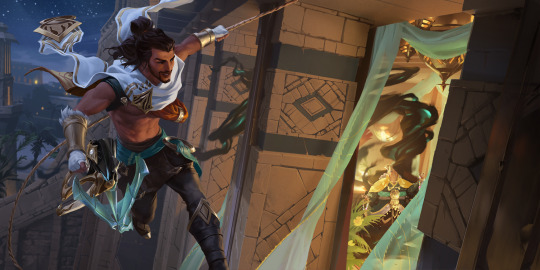
(Artwork made for Legends of Runeterra by Riot Games.)
THE BUILD
LEVEL 1 - ROGUE 1
Wow who would’ve guessed the character with “Rogue” in their title is a Rogue?! As a Rogue you get proficiency in Acrobatics, Athletics, Insight, and Deception. But feel free to swap it up to make your own Akshan! You can also get Expertise in Acrobatics for rope-swinging tricks, and Stealth to hunt down scoundrels!
When you find the scoundrels deliver swift Comeuppance with a Sneak Attack! If you have advantage or fight dirty with an ally near the enemy you can do an extra d6 of damage with your shot! And to top it off you’ve spent enough times in the streets of Shurima to know how scoundrels talk and can use Thieves’ Cant to trick them that you’re one of them, or can listen to scoundrels talking to know when to stop them.
LEVEL 2 - ROGUE 2
Second level Rogues can opt not to attack and instead use a Cunning Action to Dash, Disengage, or Hide as a Bonus Action. “To the shadows; where the scoundrels hide!”
LEVEL 3 - ROGUE 3
Third level Rogues get to choose their Roguish Archetype, and to get the ability to swing around on ropes the Thief is about as good as you’re going to get. That’s because Second-Story Work makes it so climbing ropes doesn’t cost extra movement, and also lets you jump further if you have a running start. In addition you have Fast Hands, allowing you to use your Cunning Action to make a Sleight of Hand check, use your thieves’ tools to disarm a trap or open a lock, or take the “Use an Object” action.
Now here’s the thing about using your grappling hook: most DMs would consider throwing a Grappling Hook to be a “Use an Object” action. So as a Bonus Action you can throw your grappling hook and then use your climbing speed to climb up the rope, as if you were grappling upwards! Of course talk to your DM if that’s okay, but if they let it happen you’ve practically got a flying speed at level 3! As long as there’s walls to grapple on, at least. “Akshan, away!”
And to top it off your Sneak Attack also increase to 2d6.
LEVEL 4 - ROGUE 4
Feel free to skip your first ASI if you want some Sentinel abilities first, but I consider Dexterity more important for a Rogue. More shooting, more AC, and better stealth!

(Artwork made for Riot Games.)
LEVEL 5 - WARLOCK 1
The Light Sentinels are a powerful, ancient entity who gave you powers in exchange for a set of rules. Just because the one who signed you up is dead and you don’t really follow the rules doesn’t mean you can’t still use their powers! But truthfully I just wanted a Charisma caster and you all know how much I love Warlock. Naturally powers against darkness and undead would be Celestial in nature! While you normally use The Absolver’s Healing Light to revive people healing is also useful. You have a pool of d6s equal to your Warlock level plus one. As a bonus action you can heal a creature you can see within 60 feet of you, spending dice from the pool. The maximum number of dice you can spend at once equals your Charisma modifier. Roll the dice you spend, add them together, and restore a number of hit points equal to the total. You regain all expended dice when you finish a long rest.
In addition as a Celestial Warlock you get Bonus Cantrips like the Light cantrip to see with your dumb human eyes as well as Sacred Flame cantrip to deliver Comeuppance! And of course to get cantrips you also get Pact Magic! You learn two cantrips from the Warlock list like Prestidigitation to be cool and flashy, and Mage Hand which can help you with your... legitimate business.
You can also learn two first level spells like Guiding Bolt and Cure Wounds, straight from the Celestial List! Mark a foe as a scoundrel and keep your friends alive and well! “Go; and die no more.”
LEVEL 6 - WARLOCK 2
Second level Warlocks get Eldritch Invocations: normally you get two but we’re only going to take one for now. But which one? Mage Armor is the best AC you’re going to get until you get magic armor which means that Armor of Shadows could be good, but Mask of Many Faces will let you choose your outfits however you please, and keep them from getting dirty! Basically I’m leaving you with a choice: if you want better AC but worse infiltration go for Armor of Shadows. Alternatively if you want the ability to sneak around in plain sight then Mask of Many Faces is a good choice for you!
You could also learn another Warlock spell but we’re going to wait for...
LEVEL 7 - WARLOCK 3
Third level Warlocks get their Pact Boon, and while the Absolver isn’t quite a “blade” Pact of the Blade is still the boon related to using cool ancient relic weapons! If you want to upgrade Pact of the Blade into “Pact of the Blade and also Sentinel Weapons” take Improved Pact Weapon.
Now here’s where I’m going to have to tell you to homebrew with your DM a little: for whatever reason Improved Pact Weapon lets you summon a shortbow, longbow, light crossbow, or heavy crossbow. Notice that there’s no Hand Crossbow on that list. This (technically) means that you can’t summon a Hand Crossbow, even if you take the Invocation tax for Improved Pact Weapon. Pact of the Blade does let you bind to any weapon... as long as its magical, and the lowest level magical Hand Crossbow you can get is either a +1 Hand Crossbow or a Crossbow of Warning. (Both good items to have but not necessarily something you’ll find in your adventures.) In short the official rules don’t let you have a Hand Crossbow.
Honestly I see no reason why you can’t have a Pact Hand Crossbow, but if your DM’s a stickler about it you can survive with either a Heavy Crossbow or a Longbow. (Depending on your preference.) If your DM doesn’t allow you to use a Hand Crossbow take Sharpshooter as your level 1 feat instead of Crossbow Expert, as you’ll get more use out of it.
tl;dr talk to your DM about letting Improved Pact Weapon let you summon a Hand Crossbow. If they say no edit the build with that in mind.
Anyways you can also learn more spells like Invisibility to sneak around, and Misty Step for good ol’ Flash.
LEVEL 8 - WARLOCK 4
4th level Warlocks can get an Ability Score Improvement... or a Feat! It would be easier just to grab Eldritch Adept now and talk about which Invocation you’ll use it for next level.
You can prepare another spell at this level at least, and also learn another cantrip! For your cantrip Minor Illusion can be used to make distractions while sneaking, and Mirror Image is a good spell to keep alive.
There are other spells you can take instead if you so desire. Lesser Restoration from the Celestial list is never bad to have, and Darkness can be used as a Smoke Bomb which you can’t see through with your dumb human eyes. And of course there’s the obviously good spells like Hold Person or Shatter. I’m trying to build what’s most accurate to Akshan, as well as what I believe would be the most useful. Feel free to change the build as you wish.
LEVEL 9 - WARLOCK 5
5th level Warlocks get more invocations like Thirsting Blade for a bit more attack speed with your Absolver. You can also cash in that Eldritch Adept Invocation to take One With Shadows, to hide in the shade of a wall until it’s time to surprise your foes! “That’s right; it is I!”
And finally we’ve got our revive! Take Revivify to bring someone back from the dead, as long as it was fairly recent. And the best part is you don’t even need to kill the person who killed them! But you will need a lot of diamonds, which can get expensive. “Dear friends: please stop dying. Love, Akshan.”
There’s several other third level spells you could potentially take (notably Thunder Step which might be a good replacement for Misty Step if you don’t mind throwing stealth out the window) but it’s up to you to take them.
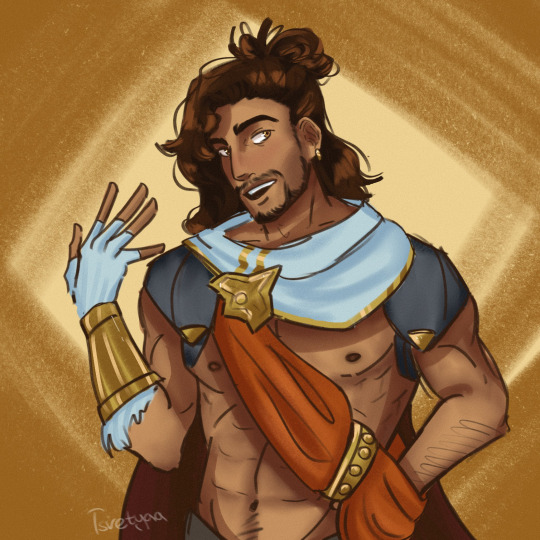
(Artwork by @Tsvetyaa on Twitter.)
LEVEL 10 - ROGUE 5
Now that you’ve got the Sentinel part down it’s time to hone your Roguish skills! 5th level Rogues can use their reaction for an Uncanny Dodge, halving the damage from an attack they saw coming. In addition your Sneak Attack increases to 3d6.
LEVEL 11 - ROGUE 6
6th level Rogues get Expertise in two more skills: Deception and Persuasion would be useful to charm your way out of danger.
LEVEL 12 - ROGUE 7
7th level Rogues can swing out of danger with Evasion: if you make a Dexterity saving throw and succeed, you take no damage! And even if you fail you only take half damage! Oh and your Sneak Attack is now 4d6. “Consider yourself, absolved.”
LEVEL 13 - ROGUE 8
8th level Rogues get an Ability Score Improvement: let’s cap off that Dexterity to be the best shot you can be!
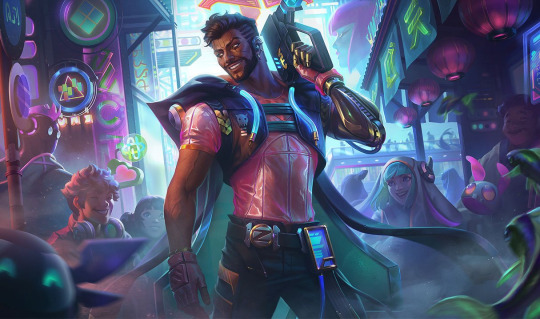
(Artwork made for League of Legends by Riot Games.)
LEVEL 14 - ROGUE 9
9th level Thief Rogues can never be found as long as they’re careful. Supreme Sneak gives you advantage on Stealth checks if you move no more than half your speed on your turn. This has insane synergy with One With Shadows as you can turn invisible and then get advantage on stealth (because for some reason being invisible doesn’t do that.) And of course if you go slow and steady you can sneak around just about anything, which is great for when you pop out to do 5d6 Sneak Attack damage! “Ha! I have you now!”
LEVEL 15 - ROGUE 10
Rogues get a few extra Ability Score Improvements... one extra, to be precise. But that means you can bump up your Charisma to be better at socialization and all that Warlock stuff.
LEVEL 16 - ROGUE 11
11th level Rogues get Reliable Talent, meaning the lowest you can roll on a skill you’re proficient in is 10. I always like to go through your skills when you get this ability to show what the bare minimum you can roll is, so...
27 on Acrobatics or Stealth
25 on Deception or Persuasion
21 on Slight of Hand
18 on Athletics
16 on Insight
And your Sneak Attack is now 6d6. What fun!
LEVEL 17 - ROGUE 12
12th level Rogues get yet another Ability Score Improvement, which of course means more Charisma!
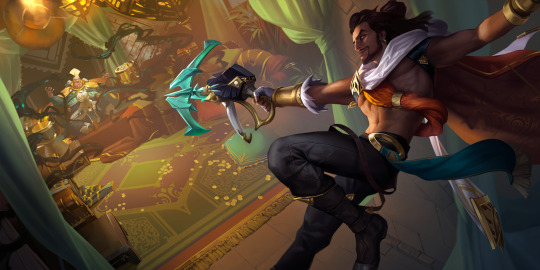
(Artwork made for Legends of Runeterra by Riot Games.)
LEVEL 18 - ROGUE 13
13th level Thief Rogues can use any Sentinel weapon they reacquisition thanks to Use Magic Device. You ignore all class, race, and level requirements on the use of magic items, letting you have fun with whatever toys you find. And when all else fails your Absolver now packs a 7d6 Sneak Attack!
LEVEL 19 - ROGUE 14
14th level Rogues are so good at sneaking they can catch the sneakers! You have a 10 foot Blindsense to know if anyone’s hiding near you.
LEVEL 20 - ROGUE 15
Our final level is the 15th level of Rogue for Slippery Mind... You get proficiency in Wisdom saving throws. That’s it. Well how’s about 8d6 Sneak Attack as a final sendoff?
FINAL BUILD
PROS
I’ve got something for you! It’s... comeuppance - Three shots with a Hand Crossbow means three chances to apply your 8d6 Sneak Attack! Akshan is all about burst and burst people down you can certainly do!
Sometimes I even sneak up on myself - Supreme Sneak, One With Shadows, and the Invisibility spell will help you move around in the shadows without being spotted. And even without that you have a minimum 27 Stealth roll thanks to Reliable Talent!
You are reclaimed. Go! Live! - It obviously goes without saying but a little bit of healing helps a lot in the long run. Everyone can appreciate a pick me up.
CONS
You try to rest and some lowlife kills one of your palls! - You have a lot more limited resources than the average Warlock as your Healing Light only comes back after a Long Rest. What’s more is that most of your spells are utility based so it might be hard to get use out of the renewable nature of Warlock spell slots. And to top it off Revivify is expensive! So you’d best be ready to spend a lot of diamonds.
I live by my own code: don’t be an ass - Your Charisma unfortunately isn’t maxed out, which means your Warlock abilities aren’t maxed out. But you don’t really need maxed out Charisma as most of your spells are utility based... I’m just saying Sharpshooter is an option.
Shadya would approve of this... I think - You missed out on level 17 of Thief Rogue which means you don’t get arguably one of the strongest Rogue abilities in the game: Thief’s Reflexes. If you’re not going to get to level 20 anytime soon I think that this build is quite good but if you’re going to get to a high level maybe ditch the revives? (It’s more than likely that Cleric can do it better.)
But you’re enough of a hero without the super-awesome relic weapon that can bring people back from the dead; that’s just an added bonus... as is the grappling hook! Use your natural awesomeness to sneak up your foes and then use your legitimately-obtained weapons-of-mass-absolution to vanquish any scoundrel in your way! And if a depressed ghost king comes knocking tell him that the maximum time limit on your revives expired. “Silly Viego, we can’t bring back those we’ve lost. I mean, I can. But not you.”

(Artwork made for Legends of Runeterra by Riot Games.)
#dnd 5e#dnd#dnd build#dnd guide#League of Legends#League of Legends Akshan#Akshan#grappling hook#dnd rogue#dnd warlock#Sentinels of Light
18 notes
·
View notes
Text
This week’s Unearthed Arcana focuses on new Feats.
Artificer Initiate is a variant on Magic Initiate for Artificer spells. It might be better, because you're getting an artisan's tool proficiency that becomes a focus for any Intelligence spells you cast, which opens awesome flavor- it lets you play an alchemist as a wizard, a painter/calligrapher (common in fiction, not really in D&D), a cook (see below), a glassblower, a weaver (a very litteral take on the Wheel of Time's system), or woodcarver (sounds stupid until you remember the first big bad from Fables). Or take cartographer's tools on an illusionist wizard. THE MAP IS THE TERRITORY, EAT MY SHIT ALFRED KORZYBSKI. It is also lets you take cure wounds on pure wizard without dipping into Eberron Dragonmark races, and its wording clarifies the issues surrounding Magic Initiate, and lets you use other spell slots.
So, great flavor possibilities and strong mechanics. This is a great Feat.
Next up is Chef, which is a revision of the Gourmond feat from a few years back. You get a Constitution of Wisdom +1, cook's utensils proficiency. You also get a flavorful variant of bard's song of rest, this time adding an additional 1d8 to healing to allies when they spend hit dice healing. You can also hand out treats that give your allies a couple of temporary hit points.
This isn't particularly powerful, but it has amazing flavor (literally)
Next up is Crusher, which specializes you into bludgeoning weapons. It gives you either a +1 Strength or Dexterity. The Dexterity may seem odd until you realize how amazing this gets on a monk.
Once per turn, when you hit a creature with a bludgeoning damage attack, you can move it up to 5 feet into an unoccupied space, if it is no more than one size larger. Critical hits give you advantage on attack rolls against the same creature with advantage until the end of your next turn. That timing clause makes it slightly less disappointing on a Barbarian (who will probably be recklessly attacking during the turn they score the critical hit), but despite the barbaric name, this is one of the few feats that is good for a monk.
Kind of weak, but it's a half-feat with some decent clauses.
Eldritch Adept lets you learn a warlock Eldritch Invocation (you can swap it every level. Prerequisite are still there, and only for warlocks, but this lets any spellcaster take Devil's Sight, Eldritch Sight, Armor of Shadows, Beast Speech, Beguiling Influence (though the Skilled Feat is strictly better), Eyes of the Rune Keeper, Fiendish Vigor, Gaze of the Two Minds, Mask of Many Faces, and Misty Visions.
Devil's Sight and Mask of Many Faces are the stand-outs here, but Misty Visions on a High Level Illusionist with Illusory Reality is horrifying.
Next up is Fey Touched, a strange variant on the High Elves' Fey Teleportation. You can increase your Intelligence, Wisdom, or Charisma by 1, and get a casting of Misty Step and a 1st level Enchantment or Divination spell. This opens up some nice possibilities: Animal Friendship, Bane, Beast Bond, Bless, Charm Person, Command, Compelled Duel, Comprehend Languages, Detect Evil and Good, Detect Magic, Detect Poison and Disease, Dissonant Whispers, Heroism, Hex, Hunter's Mark, Identify, Sleep, Speak with Animals, and Tasha's Hideous Laughter.
Bless and Bane are great picks, as is Hex/Hunter's Mark, and Dissonant Whispers is nice on a melee cleric or paladin.
Fighting Initiative lets you pick up a Fighting Style, and swap it out on level up. Archery here is the big one, due to how it is, in many cases, the equivalent of a +4 bonus to Dex.
Gunner is a feat that gives you +1 Dex and proficiency in firearms, lets you ignore their loading property, and gives a Crossbow Expert light immunity to the 5' disadvantage rule. Alright. Given how firearms need that loading property for balance, it might cause some issues, but I never really used the DMG guns in my games.
Metamagic Adept lets non-sorcerers pick up two Metamagic options, but having two sorcery points per long rest means this is actually a minor buff to sorcerers, who can work with their tools now. On the otherhand, due to sorcerer's scaling, it really incentivizes four level dips into sorcerer before going paladin, bard, or warlock.
Piercer is a strength/dex half-feat that lets you re-roll a damage die (a die, not all dice) one per turn on a hit when using piercing weapons; it also gives you an additional damage die on a hit. It's like a slightly better Savage Attacker, and, I dunno, a Half-orc swashbuckler with Orcish Fury might do fun things with it. But it's pretty bad, especially compared to Crusher.
Poisoner lets you use poison damage. It acts like Elemental Adept, allowing you to ignore poison resistance (but not immunity). You can also coat weapons in poison as a bonus action, you get posioner's kit proficiency, and can make poison doses equal to your proficiency with 1 hour of work and 50gp. And your poison causes the poisoned condition. A very cool feat that I've seen (and have) homebrewed countless times. Too bad that it does nothing to immunity, and becomes deadweight in high level play.
Practical Expert is Prodigy for everyone, almost. +1 to any attribute, a skill or tool proficiency, and expertise. It does contribute further to the edition destroying maths nightmare of 5e expertise proliferation, however.
Shadow Touched is Fey Touched for the Shadowfell. Intelligence, Wisdom, or Charisma bonus, Darkness (But no Devil's Sight), and an Illusion or Necromancy spell of 1st level. Unfortunately, this spell selection fucking sucks: Cause Fear, Color Spray, Disguise Self, False Life, Illusory Script, Inflict Wounds, Ray of Sickness, Silent Image. There are better ways to get Disguise Self and Silent Images.
Sadly, as with most Shadowfell/Feywild comparisons, very asymmetrical in the favor of the Fey.
Shield Training is a half-feat for the physical stats, and grants proficiency in shields. Donning or doffing a shield is a free action, and casters can use a shield as a spellcasting focus.
So, uh, this feat is amazing, and arcane casters who can take it should - +1 dex or con, +2 AC, free action donning, and a strong spellcasting focus. Wizards and sorcerers scream for this; a Dragon Sorcerer or Mage Armor user with only 10 Dex still has a base 15 AC with this. Also combines incredibly well with Shield Master for some bonus action ooomph on a bard.
Slasher is the third in the trio of crusher and piercer. Strength/Dex half-feat, and lets you debuff one target you hit per turn with a -10' speed until the start of your next turn, and critical hits cause disadvantage on attack roles until the start of your next turn. The probably strongest of the three.
Tandem Tactician invalidates the Mastermind, giving everyone Help as a Bonus action at 10 feet, and you can help two allies targeting the same creature. Very strong, especially with a rogue in the party, and any character who struggles to find a use for their bonus action, like Great Weapon Fighters, should try to pick this up. Very strong, very cool, and great for people like me who are constantly trying to piece together a FrankenWarlord in 5e.
Finally comes Tracker, which bumps your wisdom by 1 and gives you Hunter's Mark and advantage on Wisdom (Survival) checks to track creatures. Oddly, this might be best on a Monk who likes Flury of Blows, for some serious damage in one fight a day. Unfortunately, it is in the same document as Fey Touched, which is straight up better and more flexible than this.
All in all, not much post-commentary needed here: it seems like they regretted racial feats, as many of these are generalizations of those. I like a lot of these, and several of them parallel homebrew feats that I’ve been using in my games for years now, so it’s a good direction.
42 notes
·
View notes
Text
My D&D 5e Build for Hordak
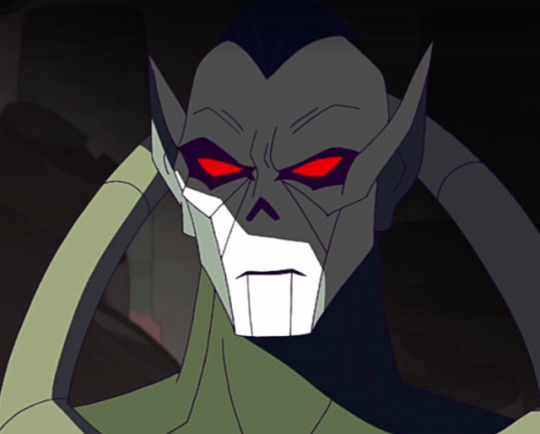
@firapolemos05 requested Hordak, I did some digging and thinking and came up with a build for this character. My judgement is based on what we’ve seen in the show and what I think suits his character best. Feel free to agree or disagree with this build or come up with one of your own.
Hordak, a member of a clone army that was rejected by his creator for having a defect in his cloning. He was sent on a suicide mission only to find himself taken through a portal and crash landing on Etheria. With the remains of a broken ship, he launched an Empire, taking over lands and territory and building his own army in the hopes of proving himself to Horde Prime. He serves as the main antagonist for most of the series before Horde Prime takes his place.
Long Post Below

***Stats***
Intelligence: Top stat. Hordak has a technological mind. He’s built machines, weapons, and portals and is one of the most intelligence characters in the series.
Strength: Second Highest. Reason being that we’ve seen him life heavy machinery in building the portal and throwing a slab of metal across the room. And he managed to push a huge beam off himself when it fell on him.
Constitution: Third Highest. I had thought of putting this lower on the list due to his chronic illness, but he did survive was having a crane fall on him and is managing to fight despite the illness.
Dexterity: Fourth Highest. Hordak can be quick when the needs aride.
Wisdom: Fifth Place. Hordak needed Double Trouble’s help to see through Catra’s lies about what happened to Entrapta.
Charisma: Dump state. Get. out! Hordak isn’t the most charming character in the series.
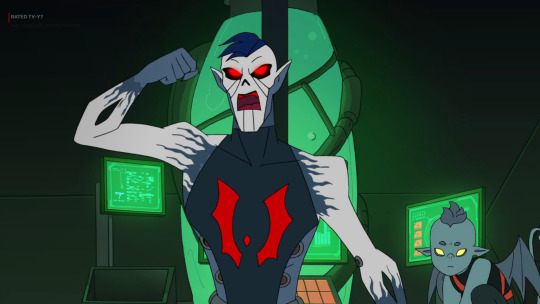
***Race***
I considered going with Variant Human again, but I just discovered the Gith- Githyanki race which I believe would suit Hordak better.
He automatically gets +1 to Intelligence and +2 to Strength.
Choose Arcana to be Proficiency skill. Hey, he must have taken time to study Etheria’s magic at one point and he has Entrapta helping him out.
Also, Hordak starts off knowing the Mage Hand cantrip.
Choose the Soldier background: This nets Hordak a Proficiency in Athletics and Intimidation.

Okay, after some thought and consideration, I’ve decided to start Hordak off as a Barbarian.
The reason for this when Hordak get’s angry, he can become quite dangerous and resilient to damage.
***Barbarian Level 1***
Hordak gets the Rage ability:
- advantage on Strength checks and Strength saving throws. - A melee weapon attack using Strength, gains a bonus to the damage roll - resistance to bludgeoning, piercing, and slashing damage.
Unarmored Defense - armor class equals 10 + Dexterity + Constitution. His suit is more of an exo-skeleton for his health condition. And his dress is a bit revealing.
For Skills choose Perception and Survival. The first few years after crashing on Etheria must have been rough at the start.
***Barbarian Level 2***
Hordak receives Danger Sense : Has advantage on Dex saves against effects he can see such as traps and spells. He’s been fighting magical princesses for years, however he can’t use this ability if he is blinded, incapacitated, or deafened.
Reckless Attack: For the first attack on his turn, he can choose to attack with advantage with melee weapons using Strength, but attack rolls against him will be at an advantage until his next turn.
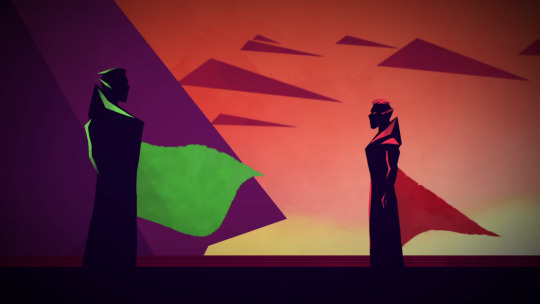
***Barbarian Level 3***
Barbarians can choose a Primal Path. For Hordak, reveres Horde Prime and conquers Etheria in his name, the Primal Path for him would be Path of the Zealot.
Divine Fury: when Raging the first creature Hordak hits on each of his turns with a weapon takes extra damage equal to 1d6 + half Barbarian level. Choose Necrotic damage he is fighting in the name of an evil cult leader.
Warrior of the Gods: Hordak is easier to raise from the dead. If any spell cast to restore life to Hordak doesn’t need any components. That’s the advantage of a having a devoted hi-tech wife.
***Barbarian Level 4***
Ability Score Improvement: Put the points into Intelligence to max it out. I know Strength is important for a Barbarian class, but there is a method to my madness.
***Barbarian Level 5***
Extra Attack: Hordak can make two attacks when he takes the attack action.
Fast Movement: His speed increases by +10 feet when he isn’t wearing heavy armor.

***Barbarian Level 6***
Path of the Zealots gives Hordak Fanatical Focus which allows to reroll a failed saving throw while Raging, but must take the new roll. Ability can only be used once per Rage.
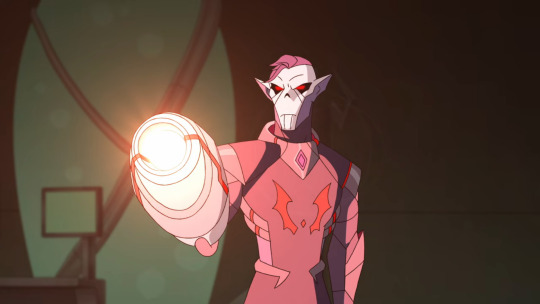
Now you’ll see the method in my madness with a high intelligence score.
We’re going into Artificier, a class the melds magic and technology, which he learned from Entrapta and from studying Etherian magic and First Ones Tech.
***Artificer Level 1***
Talk to your DM about the Optional Firearm Proficiency. If they agree, then Hordak has a proficiency in firearms, such as laser cannons!
Being an Artificer gives Hordak Magical Tinkering: Hordak’s Tinker Tools come into play which allows him to create a spark of magic in a Tiny nonmagical object with a magic effect such as giving off light, playing a recorded message (Like the Imp), etc.
Hordak is able to use his Intelligence to create magical effects in objects through spellcasting, but use his tools to do so. So choose plenty of offensive spells for Hordak to use against Princesses. I would recommend for cantrips:
Acid Splash: You hurl a bubble of acid. Choose one creature within range, or choose two creatures within range that are within 5 feet of each other. A target must succeed on a Dexterity saving throw or take 1d6 acid damage.
Fire Bolt: You hurl a mote of fire at a creature or object within range. Make a ranged spell attack against the target. On a hit, the target takes 1d10 fire damage. A flammable object hit by this spell ignites if it isn’t being worn or carried.
For 1st level spells:
Absorb Elements: The spell captures some of the incoming energy, lessening its effect on you and storing it for your next melee attack. You have resistance to the triggering damage type until the start of your next turn. Also, the first time you hit with a melee attack on your next turn, the target takes an extra 1d6 damage of the triggering type, and the spell ends. (Good for when he goes into melee against elemental Princesses).
***Artificer Level 2***
Infuse Item: Hordak can Imbue mundane items with magical infusions. At this level you can choose up to 4 infusions to know, but can replace one of them at each level.
Choose:
Enhanced Defense: Needs a suiit of armor or shield to grant a +1 bonus to Armor Class while wearing (armor) or wielding (shield) the infused item.
Enhanced Weapon: Needs a simple or martial weapon to grant +1 bonus to attack and damage rolls made with it.
Enhanced Arcane Focus: Needs rod, wand, or staff (requires attuning) a creature gains +1 bonus to spell attack rolls.
Replicate Magic Item : Any item of your choice to replicate.
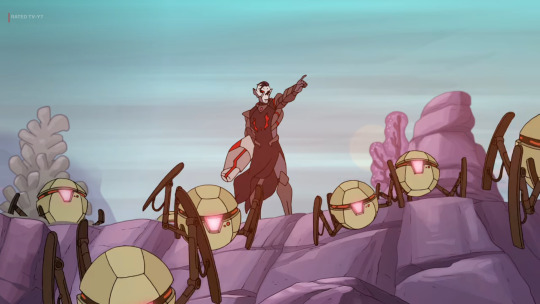
***Artificer Level 3***
The Right Tool for the Job : with tinker's tools in hand, Hordak can magically create one set of artisan's tools when needed.
Now Hordak can receive an Artificer Specialist. Take Artillerist.
Tool Proficiency: Gain proficiency with Wood Carver tools, but to better fit Hordak’s character, I would go with Smith’s Tools if the DM allows it.
Hordak gains 2 additional spells.
Shield: An invisible barrier of magical force appears and protects you. Until the start of your next turn, you have a +5 bonus to AC
Thunderwave: A wave of thunderous force sweeps out from you. Each creature in a 15-foot cube originating from you must make a Constitution saving throw. On a failed save, a creature takes 2d8 thunder damage and is pushed 10 feet away from you. On a successful save, the creature takes half as much damage and isn’t pushed.
The golden part of this level is Eldritch Cannon. Hordak can create small or tiny canons. Think Horde Robots. They can have one of three effects: Flame Thrower, Force Ballista, and Protector.
***Artificer Level 4***
Ability Score Improvement: Max out Intelligence to attain more spells and make them more powerful. If Intelligence is already maxed out, you can put them into Strength so Hordak can hit harder when in melee or you can round out the other ability scores.
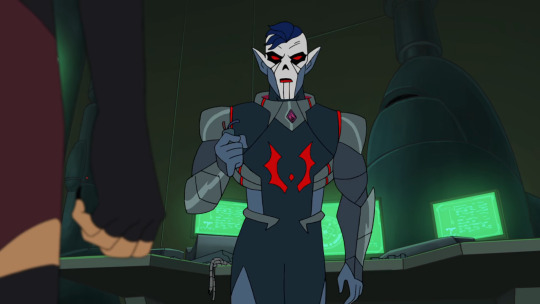
***Artificer Level 5***
Arcane Firearm: Hordak can turn a rod, wand, or staff into an Arcane Firearm (such as an Arm Cannon) to case offensive spells. Doing so gives a 1d8 bonus damage to spells. If the spell hits multiple targets, choose one to take the bonus damage.
Hordak can now use 2nd level Artificer spells. I recommend:
Heat Metal : Hordak can cause a metal object (armor for example) to glow red-hot. Any creature in physical contact with the object takes 2d8 fire damage when you cast the spell. Until the spell ends, you can use a bonus action on each of your subsequent turns to cause this damage again.
Also Artillerist gains two additional spells.
Scorching Ray: You create three rays of fire and hurl them at targets within range. You can hurl them at one target or several. Make a ranged spell attack for each ray. On a hit, the target takes 2d6 fire damage.
Shatter : A sudden loud ringing noise, painfully intense, erupts from a point of your choice within range. Each creature in a 10-foot-radius sphere centered on that point must make a Constitution saving throw. A creature takes 3d8 thunder damage on a failed save, or half as much damage on a successful one. A creature made of inorganic material such as stone, crystal, or metal has disadvantage on this saving throw.
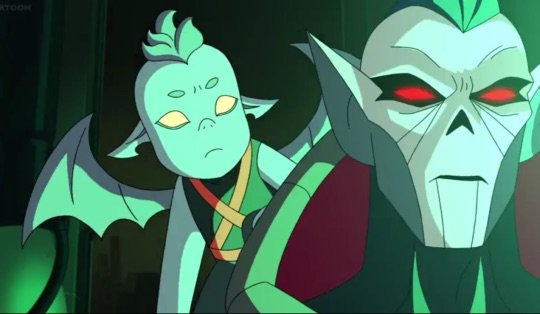
***Artificer Level 6***
Tool Expertise: proficiency bonus is doubled for any ability check you make that uses your proficiency with a tool.
Also, Hordak gains two additional Infusions.
Pick Homunculus Servant so Hordak can create his own Imp, a tiny construct that obeys commands. Repulsion Shield : grants a +1 bonus to AC when using this shield. Also has 5 charges to push an attacker back 15 feet as a reaction to being hit by melee weapon.
***Artificer Level 7***
Flash of Genius: As a reaction, Hordak can add his intelligence modifier to an ability check or saving throw of a ceature within 30 feet of him.
***Artificer Level 8***
Ability Score Improvement: By now Intelligence should be maxed. Put points into Strength if you are having Hordak wade into melee battle. And/Or, you could get the War Caster feat which will make it easier for Hordak to cast and maintain spells in battle.
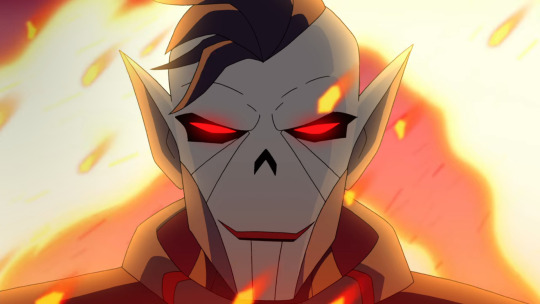
***Artificer Level 9***
Explosive Cannon: Eldritch Cannons now cause more damage with additional 1d8 damage and Hordak can have them self-detonate for 3d8 force damage on a failed Dex save.
Hordak can now use 3rd level spells.
Dispel Magic: Choose any creature, object, or magical effect within range. Any spell of 3rd level or lower on the target ends. For each spell of 4th level or higher on the target, make an ability check using your spellcasting ability. The DC equals 10 + the spell’s level. On a successful check, the spell ends. (Hordak must have been studying a means to remove magical effects, plus this spell is super useful).
Plus being an Artillerist grants two additional spells.
Fireball: A bright streak flashes from your pointing finger to a point you choose within range then blossoms with a low roar into an explosion of flame. Each creature in a 20-foot radius must make a Dexterity saving throw. A target takes 8d6 fire damage on a failed save, or half as much damage on a successful one. The fire spreads around corners. It ignites flammable objects in the area that aren’t being worn or carried.
Wind Wall: A wall of strong wind rises from the ground at a point you choose within range. When the wall appears, each creature within its area must make a Strength saving throw. A creature takes 3d8 bludgeoning damage on a failed save, or half as much damage on a successful one.

***Artificer Level 10***
With Entrapta’s help, Hordak can become a Magic Item Adept: he can attune up to four items at once instead of just two. And it takes a quarter of the time to craft a common or uncommon magical item and doing so costs half the gold.
And Hordak can learn two more Infusions.
Spell-Refueling Ring (Unearthed Arcana) - A ring that can recover expended spell slots. (Hordak can keep throwing spells back at Princesses)
Mind Sharpener (Unearthed Arcana) - Robes (or armor) that can allow the wearer to maintain a spell as a reaction if they failed a constitution check.
***Artificer Level 11***
Spell-Storing Item: Hordak can store a 1st or 2nd level spell inside an item for a creature to use
***Artificer Level 12*** Ability Score Improvement: Intelligence should be maxed. Strength should be maxed. Also round out any Ability Scores. Or you can get the War Caster feat.
***Artificer Level 13*** 4th level spells are now available. I recommend:
Arcane Eye: You create an invisible, magical eye within range that hovers in the air for the duration. You mentally receive visual information from the eye, which has normal vision and darkvision out to 30 feet. The eye can look in every direction.
***Artificer Level 14*** With the help of his beloved Entratpa, Hordak becomes a Magic Item Savant. He can attune up to five items with magic and he can ignore all class, race, spell and level requirements to use any magical items.
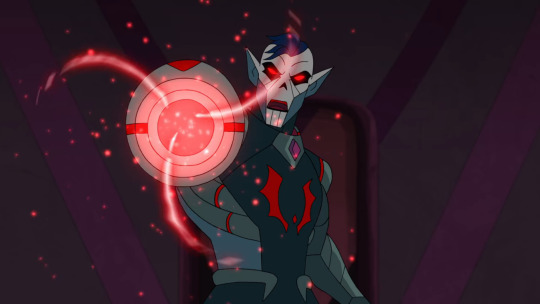
And there you have it. My version of Hordak in D&D 5e. With the Barbarian levels he can deal decent melee damage and withstand receiving damage and gaining extra strength while Raging.
As part of his background and his close relationship to Entrapta, he can infused magic into items and use offensive spells against the Princesses in his conquest of Etheria.
55 notes
·
View notes
Note
im new to DMing, and while i seem to have gotten the hang of most things well, im super confused when it comes to running battles (especially when theyre my own monsters) how do i balance a battle? how do i tell how many enemies/how much health per enemy = fair for certain amounts of players? is there a chart or resource somewhere you know of, or is it all intuition? (bonus question: how long should normal and boss encounters last irl time wise?) thanks so much!
thanks for sending me this question! this answer is particularly huge… you have been warned.
as usual, here’s the tl;dr:
- for an easy to moderate challenge, have the same (or fewer) number of enemies as there are players;
- for an advanced challenge, outnumber the players;
- lower your enemies’ AC to something that your players can hit 60-70% of the time;
- in exchange, buff your enemies’ HP;
- feel free to fudge hit points whenever you want;
- utilize the “minions” mechanic from 4th edition;
- for boss battles, introduce special bonus actions, reactions, and villain actions;
- combat usually lasts 3-4 rounds: plan accordingly;
- ask yourself: why is this combat happening? what narrative/dramatic and character stakes can i introduce?;
- and have fun!
i want to preface my answer by saying that i don’t enjoy easy combat – unless played for laughs/comedy, or used to foreshadow something plotwise (like a goblin scout’s death alerting the goblin horde at large), i hardly ever throw an easy combat encounter at my party.
so, the following advice is given with challenging the players in mind – either moderately, immensely, or impossibly. i guess i’m just a big sucker for jim murphy/matt colville-style DO OR DIE challenges. otherwise, what’s the point?
another preface: this answer is given in the spirit of avoiding the “slog” – the combat encounter where it feels like baddies and PCs are just stepping up to the plate, whacking at each other, and stepping back down. that’s boring. and boring combat is the worst. sometimes it’s unavoidable – we all have our off days, nothing wrong about that – but the less that it happens, the more fun that everyone has! right?
now, on to the answer itself!
first of all, i’ve already written an answer to an ask a little while back about combat that might be useful to you. click here to read about how to make more action-oriented monsters, especially for boss battles and random encounters that you want to feel significant and deadly.
second of all, here’s the 5e CR encounter calculator i used to use all the time. it’s extremely intuitive and has toggles for number of players, level of players, monster CR/EXP, and how difficult encounters would be rated (easy, medium, hard, deadly).
third of all, i never use that calculator anymore.
over the course of the 2.5 years i’ve spent DMing 5th edition, there are three main things i’ve learned that can drastically increase, or decrease, the difficulty of a combat encounter. they are: # of baddies, armor class, and # of hit points.
regarding # of baddies. due to how the action economy in 5e plays out, the more creatures there are on either side of a combat, the bigger the advantage that side has. it’s just kind of how it works. so, an easy way to bump up the difficulty: throw more monsters at the players than there are players.
the one soft exception is boss battles. personally, i fucking LOVE having just ONE, super badass, super hard to kill, hardcore boss that the party gets to face down during crucial turning points in the campaign. it makes me feel like i’m running fucking Dracula in Netflix’s Castlevania against some lovable and deadly dumbasses. it’s great. it’s fun. it’s thrilling. to make bosses as challenging (and therefore rewarding) as possible, i highly recommend reading the ask i linked earlier in this reply. (click here for the link again.)
now, i say it’s a soft exception because i like giving my bosses minions. i basically utilize the 4th edition (i think?) “minion” mechanic where the AC, bonus to hit, and damage of all minion creatures are the same as regular versions of the creature. the only difference is, they have 1 HP.
this can give the PCs the awesome feeling of wading through waves and waves of minions – say, dozens of zombies, as an evil lich cackles upon their raised stone dais 80 feet away. i don’t utilize this too often because then it can feel tiring to the party. but done sparingly, and with narrative stakes, it can be quite thrilling! (that maxim is also true for basically any kind of combat encounter in D&D.)
regarding armor class. obviously, the higher the armor class, the harder the challenge. if you can’t hit the damn thing obviously you can’t kill it. i personally like to pitch the AC of my enemies a liiittle bit lower, to increase my PCs’ probability of hitting. the exact number of the armor class will depend on your players’ level.
as a super general guide for players at level 3, 10-13 is easy, 14-15 is moderate, 16-17 is challenging (heavily favoring 17), and 18+ is very challenging/almost impossible.
just so you know, i generally set my enemies’ ACs for a level 3 party to be 13 for less important creatures, and 14 for more important creatures. i’d probably set the AC to be 15 or 16 for a mini-boss, and 16 or 17 (if i’m feeling cruel lol) for a boss.
obviously, this scales as your party levels up, finds magical items, and gains special features and boons. i would scale the difficulty by 1 when they hit level 4 and get an ability score improvement, and then by 1 every 2 levels or so.
in other words, at level 4, i’d consider an AC of 11-14 to be easy, 15-16 as moderate, 17-18 as challenging (heavily favoring 18), and 19+ as very challenging/almost impossible. and by the time your party is levels 12-16, AC can often feel like it doesn’t freaking matter anymore because they’ll be able to hit, like, fucking everything. anyway.
there’s some nitty gritty mathematics about this if you like to get granular. this is a good video about dice math, armor class, and calculating advantage mathematically if that sort of thing interests you.
regarding # of hit points. honestly, i fudge this most times. because i like to scale my AC on the lower end, in exchange, i make my creatures fucking FAT. like, i’ll look at their stat block in the monster manual, and add 30-50% to what they already have. sometimes i’ll straight up double or even triple it.
for example, the spectator normally has 39 hit points, but i gave my spectator ~100, because it was a miniboss. i did, however, keep its armor class at 14 because that meant my players, at 3rd level, would be able to hit it 60-70% of the time. this strategy of mine tends to work out, because my players are usually able to dish out a LOT of damage per round. (we have a barb, a fighter, and a warlock in the party lol.)
something i did in the spectator fight, that i wish i didn’t do, was stay faithful to the number of hit points it had. the barbarian ended up killing it with a rather anticlimactic attack. i know for certain that my warlock, which was next in the initiative order, had this SUPER cool and character-relevant attack planned. what i would do differently, is keep the spectator alive just long enough for my warlock to do their cool fucking move, and have that move kill the monster.
and now for the big takeaway. combat, for me, is all about giving my players a chance to shine, be badass, utilize their class abilities, and be creative. just like any other aspect of d&d, such as roleplaying and exploration, combat is an exercise in collaborative storytelling (for me, at least).
i rarely introduce combat that doesn’t tie into an A plot, a B plot, or a side quest that the PCs are chasing. i don’t have anything against random encounters – in fact, i ran some RE’s in the second-most recent session – but what makes combat fun for me as a DM is the fact that it advances story, and potentially deepens the players’ understanding of their character.
so, before you throw your players into a combat situation, ask yourself: why? how can i make this narratively dramatic – and not just a slogfest?
bonus answer: most combat encounters will struggle to last beyond three, maybe four, rounds. especially if there are an equal or fewer baddies to the player characters. however, this isn’t necessarily a bad thing. in fact, if combat went on for five, six, seven rounds, it can begin to feel like… well.. a slog.
so make the most out of your three, four rounds, and make each combat encounter unique! how about an environmental challenge? slippery ground, swinging axes, pools of lava, a sudden earthquake, a portcullis dividing the party, water filling the room.
or roleplay/plot-related challenges? maybe there’s a circle of mages attempting to summon a demon that are protected by enchanted suits of armor that the PCs need to hack through. maybe there are hostages. maybe there’s a powerful magical artifact that the baddies and PCs both want, and the challenge in the combat lies in who can most deftly and efficiently maneuver through the clockwork maze protecting the raised dais the item resides upon.
145 notes
·
View notes
Text
Building Rose Wilson in D&D 5e
I kinda cannot find myself other things to do, especially as I decided to not do anything for April Fools this year because, well, how do you even top the nonsense that is happening. And feel like making one more of those, so let’s build another daughter of an assassin

Because I shamelessly lifted the template for writing these from Tulok the Barbarian, let’s start with defining some goals for this build. First of all, we need to be able to move and strike like a daughter of enhanced super-soldier with assassin training would. Second, we need to be able to see the future and use it to our advantage. Third, we need a sword striking like a weapon from the future. Finally, we need to be able to do all the acrobatic fighting in armor. Rose’s most popular costume is some weird-ass skintight chainmail, which is likely bad for the skin as hell. Don’t worry, if you’d rather have her indifferent, lighter outfit, I’ll leave a few alternatives to make that work too.
For Ability Scores, we’ll be using Standard Point Array, 15, 14, 13, 12, 10, 8. If you or your DM prefers a point buy or rolling, use these as guidelines, just remember you need to have at least 13 in Charisma, Dexterity, and Intelligence, there is going to be some multi-classing here.
Strength: 10, we don’t need it but you are supposed to have at least somewhat enhanced strength.
Dexterity: 14, you’re extremely acrobatic and fast, enough to keep up with likes of Cass Cain or your asshole father.
Constitution: 12, you can take a hit and sadly we’ll be straying from higher hit dices this time.
Intelligence: 13, you are much smarter than some give you credit for.
Wisdom: 8, you tried to challenge Big Barda to a fistfight, that’s the opposite of this ability score.
Charisma: 15, you may act aloof to people but if you can interrupt Wonder Girl and Supergirl romantic moment with a rocket launcher and not get pulverized, you know how to talk yourself out of trouble.
Race: It’s how D&D calls species! Sorry, Christoper Priest was about burst through the door to remind us Rose is Hmong, and that’s a serious quarantine breach. Anyway, I think she counts as a metahuman, which sounds a lot like Variant Human. If you have an issue with it, pick Half-Elf, but we’ll go with Human. Variant Humans get +1 to two Ability Scores, pick Charisma and Intelligence. You get one free skill proficiency, I’d go with Acrobatics, and one free language, pick something campaign relevant. Finally, you get a free feat. Human Determination allows you to add +1 to your Dexterity and once per long rest give your self an advantage on an ability check, attack roll or a saving throw.
Unarmored Rose: Redistribute +1s so that you have 16 in Charisma and Dexterity.
Background: I wasn’t exactly sure which one to pick, but Rose and her father share that weird thing in their outfits that make them look like pirates so why not, let’s go with that. Criminal and Soldier can also work if, but I like the idea too much. Pirate gains proficiency with Athletics and Perception, navigator’s tools and water vehicles and gain Bad Reputation, which lets you get away with minor offenses in a civilized settlement because people are afraid of you and won’t report it. Rose can be rude to people and get away with it after all.
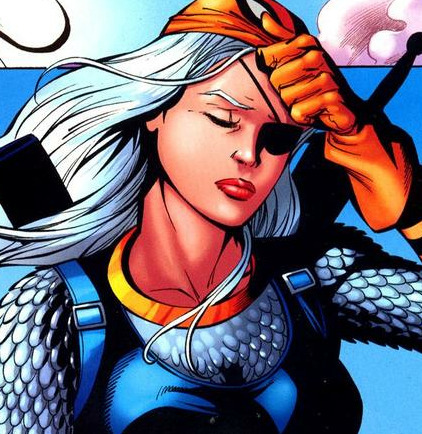
Now to the meat of the building, character levels
1st Level: We’ll start as a Rogue, gaining proficiency in 4 skills - Intimidation, Deception, Stealth, and Persuasion - Thieve’s Cant secret language, Dexterity and Intelligence saving throws, thieve’s tools, simple weapons, short and longswords, rapiers, hand crossbows, and light armor. Moreover, you can gain expertise in two I’d recommend Acrobatics and Athletics - of those, doubling your Proficiency modifier for them.
Rogue’s also gain Sneak Attack, allowing you to add 1d6 to a ranged or melee attack made with a light or finesse weapon when you have an advantage to attack roll or another, not incapacitated, an enemy of the target is within 5 feet of it and you don’t have a disadvantage on the attack roll. Rapier is a finesse weapon and can easily be refluffled to serve as a stand-in for majority of swords Rose uses.
2nd Level: We’ll now take a quick dip into the Warlock to get you that sword.
Warlock gets an Otherworldly Patron. Hexblade has one forged with some sort of weapon of unknown origin that may be sentient. It has been sort of left ambiguous if Willow is a spirit possessing you or split personality caused by brain trauma, but whichever version you want you can work into this. As Hexblade you are Hex Warrior, gaining proficiency with Medium Armor, shields and martial weapons. Once every long rest you can pick a single weapon you are proficient with that isn’t two-handed and can use your Charisma in place of your Dexterity or Strength for attack and damage rolls made with it.
You also get Hexblade Curse, letting you once per short or long rest curse a single opponent within 30 feet from you that you can see as a bonus action. As long as the target is cursed, which is until a minute passes, either one of you dies or you are incapacitated, you add your Proficiency Bonus to damage rolls against it, crit against it on roll of 19 or 20, and if they die you regain hit points equal your Warlock Level + your Charisma modifier.
As a Warlock, you gain access to Spells. You know two cantrips and two spells and have a single spell slot you regain on short rest. Spells that require an attack roll do it with modifier equal your Charisma Modifier + your Proficiency Bonus, if your target needs to make a saving throw against your spell, Difficulty for it equals the sum of these two numbers +8.
Blade Ward is a Cantrip that until the end of your next turn grants you resistance against bludgeoning, piercing and slashing damage. Your HP will not be something to write home about, spoiler warning.
Booming Blade lets you attack as a part of casting a spell, on a hit your target takes damage as from normal attack but if they willingly move until the start of your next turn they take 1d8 thunder damage.
Hex lets you curse one creature you can see with 90 feet, making you deal it extra 1d6 necrotic damage when you hit it with an attack and grants it disadvantage on all checks for one Ability Score of your choice. It is a concentration spell and lasts up to 1 hour and if your target dies early, you can just move it to another target as a bonus action on your next turn.
Shield is cast as a reaction when you are hit by an attack or Magic Missile, allowing you to add +5 to your AC until your next turn, including against the attack or Magic Missile that caused you to cast it. Play it as you being hit was just your vision and you managed to avoid the damage.

3rd Level: Back to the Rogue now, 2nd Level Rogue gets Cunning Action, allowing you to take Dash, disengage or Hide as a bonus action or use said bonus action to Aim, giving you an advantage on next attack as long as you don’t move during this turn.
4th Level: 3rd Level Rogue bumps their Sneak Attack to 2d6 and gets to choose Roguish Archetype. Swashbuckler gains rakish audacity, letting you add your Charisma bonus to your initiative rolls and use Sneak Attack if you are within 5 feet of an opponent and no other creature is within 5 feet of you and you don’t have a disadvantage on the attack roll. You also gain Fancy Footwork, meaning if you make a melee attack against a creature, it cannot make opportunity attacks against you until the end of your turn. So if your dad drugged another heroine to fight you, you can strike her, don’t even need to hit, and then just slip past her to stab Slade next turn. And if you hit her with Booming Blade she cannot even chase you without taking more damage.
Have I mentioned your dad sucks?
5th Level: 4th Level Rogue gets an Ability Score Improvement, but we’ll go with a feat - Medium Armor Master lets you increase your Dexterity by 1, increases maximum bonus from Dexterity to AC you gain in Medium Armor from 2 to 3 and removes disadvantage Medium Armor imposes on Stealth checks. Rose’s iconic suit is some weird skintight chain shirt or scale armor, but you can even pick up Half-Plate for a total of 18 AC, 20 with a shield, if you want.
Unarmored Rose: Take the feat we will be taking when Rose hits Rogue 8
6th Level: 5th Level Rogue gains Uncanny Dodge, letting you use your reaction to halve damage against you when you are hit by an attack. Again, play it as you seeing the vision of attack and using that to be able to avoid it. Also, your Sneak Attack increases to 3d6.
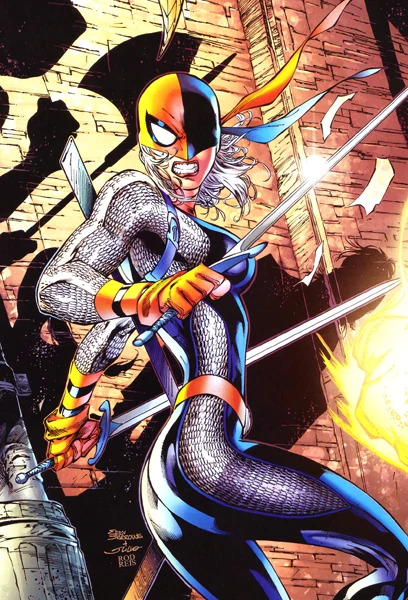
7th Level: One more detour, time to start messing with the fate some more. No, not with Doctor Fate, that would be lethal. Anyway, 1st Level Wizard gets a Spellbook with 3 Cantrips and 6 1st Level Spells and 2 1st level Spell Slots. The Save DC and Spell Attack rolls are like Warlock’s but use Intelligence instead of Charisma. Wizard and Warlock count their spell slots separately but you can use one class spell slots to cast spells you know from the other class. Wizard recovers them on a long rest but Arcane Recovery lets you once per day on a short rest recover a number of spell slots equal half of your Wizard level, rounded up.
Friends lets you for the duration gain advantage on all Charisma checks against one creature, but once it ends it is aware what you did and gets angry at you. The fact this is a cantrip explains some things about few of Rose’s relationships.
Message lets you send a small message to another creature and get a short reply. You can use it as a team communicator for rest of the Titans.
Shocking Grasp is a paralyzer, letting you make a meele spell attack against a single target to deal it 2d8 lightning damage (it scales as most damage-dealing cantrips) and making it unable to take reactions until start of it’s next turn.
Cause Fear is a vial of fear toxin you stole from Scarecrow that forces a target to make a Wisdom Saving throw or be frightened of you for the duration or until it akes a saving throw on one of its turns. Doesn’t work on constructs or undead. Honestly, it would be much better as a Warlock Spell but I wanted to get Shield faster, feel free to switch the two around.
Disguise Self is your holographic projector that lets you alert your looks to make you look like another humanoid in the same size category and having the same array of limbs.If fails under closer scrutiny as it is an illusion.
Feather Fall lets you slow down the fall of you and up to five creatures within rage and if those affected reach the ground before the spell ends, they take no damage. I guess it’s your parachute.
Fog Cloud is a fog grenade, obscuring heavily everything within the area for up to 1 hour or until wind disperses it. Use it to retreat if things go badly.
Protection from Evil and Good gives all aberrations, celestials, elementals, fey fiends and undead disadvantage on attack rolls against you (or someone else you use it on), makes you immune to being charmed or frightened by them or, if you already were, grants advantage on saving throws to break out of it. I don’t know if Granny Goddess counts as a celestial but this could be pretty useful against mind control stuff done by Hellfire Club or when Blackest Night falls from the sky again.
Sleep allows you to roll 5d8, add the results and then put to sleep creatures in the spell’s rage of your choice, starting with the one who has the least amount of HP, are put to sleep until the combined HP of creatures you put down this way equals the sum of your rolls. Sleeping gas, a friend of any human fighting superheroes and supervillains on regular basis.
8th Level: 2nd Level Wizard gets an extra Spell Slot and gets to choose a School. School of Divination grants you Portent - after finishing a long rest you roll 2 d20s and write down the results. Until next long rest, you can use these rolls in place of an attack roll, saving throw or an ability check made by you or a creature you can see. The downsides are you have only two of them, each is of single-use, if you don’t spend them they’re lost, you need to declare you use them before the dice is rolled, and you can only do it once per turn. But these are extremely powerful and let Rose act in accordance of visions she sees. Hell, it can easily be played in line with how Doctor Villain theorized her powers work

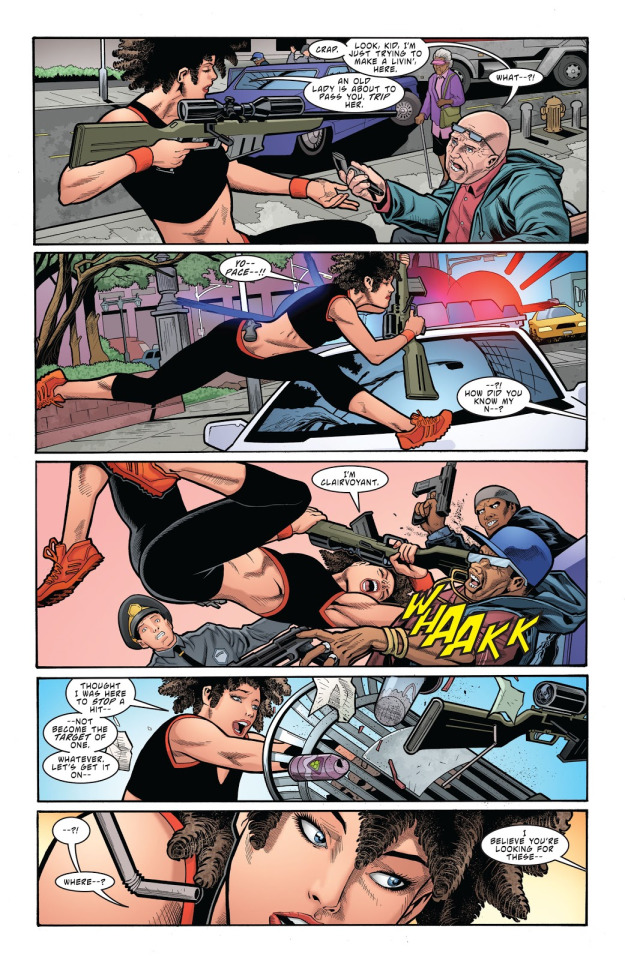
Pretty much how it is working.
9th Level: So now that made these detours, let’s go back to Rogue for some more fighting prowess and better skills. 6th Level Rogue gains Expertise in two more skills, I’d go with Intimidation and Persuasion.
10th Level: 7th Level Rogue gains Evasion, letting you take no damage instead of half damage if you succeded on Dexterity Saving Throw against all spells and effects that ask of one. Your sneak attack increases to 4d6.
11th Level: 8th Level Rogue gets an Ability Score Improvement, but we’ll instead take one last feat - Lucky gives you 3 luck points per long rest that you can spend to roll one additional die on an attack roll, ability score or saving throw and choose which result is used. You can also spend them when a creature attacks you to roll a d20 and decide which roll the attacker is using.
Unarmored Rose: Spend the rest of your Ability Score Increases to round up first your Charisma and then Dexterity.
12th Level: 9th Level Swashbuckler gains Panache, letting you make a Persuasion check against target’s Insight - if they fall nonhostile creature is charmed by you for one minute and hostile one gains disadvantage on attack rolls against creatures other than you and cannot make opportunity attack against a creature other than you for 1 minute or until you are more than 60 feet apart or another ally hits them with an attack or a spell. Also, your Sneak Attack increases do 5d6.
13th Level: 10th Level Rogue gets an Ability Score improvement, time to invest into Charisma.

14th Level: 11th Level Rogue you gain a Reliable Talent - whenever you roll for a skill you are proficient with, you treat rolls below 10 as 10. And your Sneak Attack increases to 6d6.
15th Level: 12th Level Rogue gets another Ability Score Improvement, round up your Charisma.
16th Level: 13th Level Swashbuckler can execute an Elegant Maneuver to, as a bonus action gain an advantage on the next Acrobatics or Athletics check you’ll make during the same turn. And your Sneak attack rises up to 7d6.
17th Level: 14th Level Rogue gains Blindsense, which lets you discern the location of hidden or invisible creatures near you.
18th Level: 15th Level Rogue gains Slippery Mind, which means proficiency in Wisdom saving throws. Which is good if Slade tries to gaslight you into his new bullshit again. Your Sneak Attack increases to 8d6. Also, your dad sucks, have I mentioned that?
19th Level: 16th Level Rogue gets our las Ability Score Improvement, increase your Constitution for better Hit Points and Concentration, remember your HP increases also retroactively.
20th Level: Our capstone is the final ability of Swashbuckler, Master Duelist, which lets you reroll an attack roll with an advantage if you miss it once per long rest. And your Sneak Attack increases to 9d6
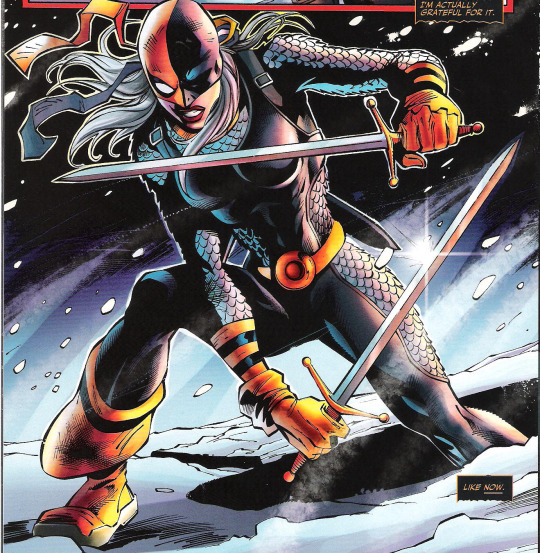
Overview: Rose Wilson is a Swashbuckler Rogue 17/School of Divination Wizard 2/Hexblade Warlock 1. Let us see how good this build is:
Pros: First of all you are incredibly hard to hit or hurt in general, with AC around 18 or 20 and multiple ways to reduce the damage or turn a hit into a miss - Uncanny Dodge, Evasion, Shield, Portent, Lucky. Second, you have a lot of ways to screw with your own dice, making them do what you want through a combination of luck and foresight. There is a reason why Lucky Divination Wizard is seen as one of the most powerful things in the game and you add to this Reliable Talent, Master Duelist, Elegant Maneuver, Friends, Hex and Hexblade Curse. Third, with Hex, Hexblade Curse, Booming Blade and Sneak Attack you can deal huge damage, especially with your increased crit chance. You are also very Finally, you are incredibly mobile for someone in a half-plate, which will catch many opponents off-guard.
Cons: Your HP is decent but nothing to write home about, few hits will drop you into the danger area of Power Word: Kill easily. Your sword may be enhanced but is not magical so unless DM gives you a magical weapon a lot of enemies will be able to resit your damage or simply be immune to it. A lot of your abilities compete over your use of reaction or bonus action as well, making them somewhat redundant. Finally, your Intelligence and Constitution are not that good and it’s gonna hurt some of your spell rolls, especially concentration. Also, if you abuse your future-seeing powers too much DM will hate you.
Overall, however, you are a very good party member, fitting as both a skill monkey and damage-per-turn and even a small-part controller or defender in a pinch with power to bend dice to your will. Sweep into the battlefield, hit hard, move out and have the opponent have to go through Superboy to hit you back. Just remember that you work better as a part of a team so maybe don’t antagonize party members too much. Except if you’re on a team with Slade.
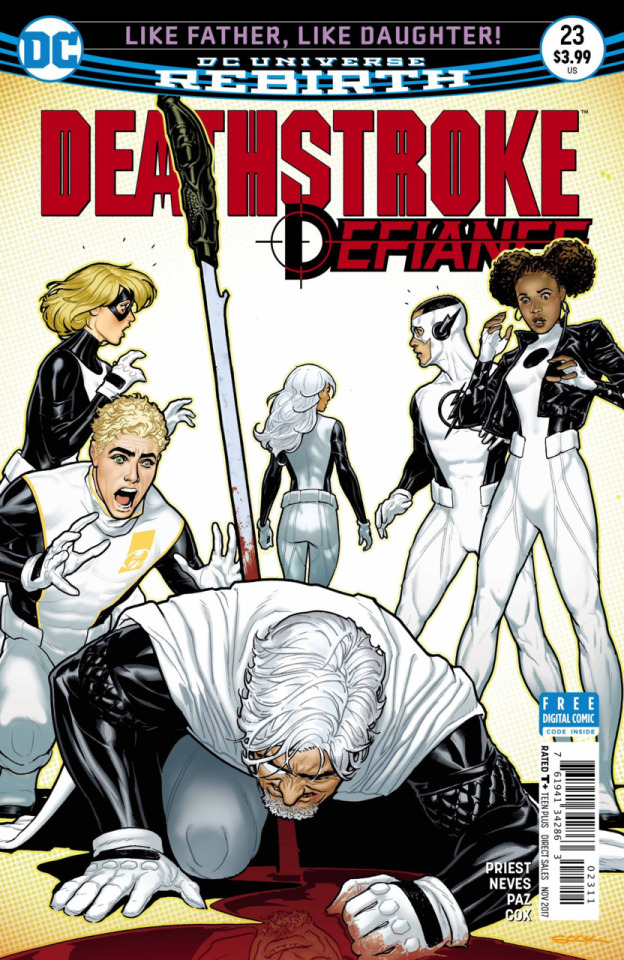
Your dad sucks.
Alternatives:
If you don’t like the whole Willow thing and don’t feel like refluffing and fixing it, skip Hexblade level for one more of Rogue, you’ll gain Elusive, ensuring no attack against you is made with an advantage.
If your Ability Scores are so high you can get an extra feat, consider either Defensive Duelist, which lets you use your reaction to add your Proficiency bonus to your AC when a creature hits you with a melee attack. Or, if you play Half-Elf Rose, Elven Accuracy for +1 to either Dexterity, Intelligence, Wisdom or Charisma and an ability to roll an additional dice when you make an attack roll with advantage using any of these 4 Abilities.
- Admin
16 notes
·
View notes
Text
A D&D 5e Build: Ron Stoppable
I did one of these sometime last year for Halloween and just wanted to do another, so here it is. First up: Why am I attempting to build Ron and /not/ KP? Simply put, Kim is a fairly straight forward build in 5e terms. She’s an Inquisitive Rogue with a single dip into Monk. You could give her some Fighter levels (that UA Unarmed Fighting Style is so tempting) to keep up with Shego’s combat prowess, but her brain is honestly her key feature, making those Rogue levels very valuable (11 at minimum as far as I’m concerned). She’s you’re basic, average girl, and she’s here to save the world. Ronald, on the other hand, is remarkable by just how unremarkable he is while still somehow keeping up with Kim. Barely. For those who didn’t watch Kim Possible when they were younger or don’t have Disney+, he might not even seem like an adventurer. But Ron’s amazing in game terms; he’s at that level of naco cheesiness I just love to play. Plus, he has Rufus, and everyone loves Rufus. Spoilers may appear.

Let’s get into it:
I’m going to be using the standard point array from the PHB. If you would like to roll for stats, just keep in mind where to put your higher and lower rolls.
Ron’s 15 is going into Wisdom. He may seem like a totally inept doof, but he’s incredibly insightful and holds onto his own philosophies. Also, his best friend aside from KP is a naked mole rat (a very smart one at that, but that’s cartoon logic). I’m going to put 14 in Charisma. Ron isn’t intended on being conventionally attractive, but Charisma =/= being hot. It’s all about your presence and ability to get people to listen to you and consider what you’re saying. Ron is somehow able to casually talk with so many villains, so his CHA must be high. Also, he’s an honorary Pixie Scout. 13 is going straight into Constitution. He is R-unstoppable after all... He can take a real beating from even the more threatening foes and eats so many nacos that an above average CON is the only reason he hasn’t been hospitalized for his diet. I’ll give 12 to his Dexterity. He’s dodged lasers, booby traps, and incoming fire from all sorts of things. An adolescence of fighting robots and super-humans will leave you light on your feet and your hands. This may sound weird, but I’m giving his Strength the 10. He’s worked in retail and has lugged around some pretty heavy looking things. And that leaves Intelligence with 8. Ron isn’t the sharpest tool in the shed. He says good stuff, but don’t ask him to tutor you for the upcoming exam unless it’s a subject he excels at without question. I know he was kind of a genius when he became evil that one time, but I’m going to rationalize that as his INT & WIS swapping places when his alignment got shifted. Ron’s a Neutral Good guy with Chaotic leanings, so going Evil is bound to mess with your brain in more ways than one.
STR 10 || DEX 12 || CON 13 || INT 8 || WIS 15 || CHA 14
Ron’s a Human of the Variant variety, but if you want to play him as a Bugbear, that’s cool I guess. I’m not your dad. I’m going to bump up his WIS to 16 and CON to 14. And I’m going to give him the Magic Initiate (Wizard) feat. Prestidigitation & Mending can reflect parts of his Movie Makeup Magic Kit, but I’m really taking this feat for Find Familiar so we can have Rufus right off the bat. He’ll also get the Animal Handling skill because Rufus loves him.
For his Background, I’m going with Entertainer for proficiency with Acrobatics, Performance, Disguise Kits, & a musical instrument of your choice. This solidifies his place as the Middleton Mad Dog mascot, the costume of which he made using his MMMK, and he has disguised himself as Mr. Dr. Possible & The Fearless Ferret. However, if you feel that the By Popular Demand feature doesn’t fit Ron quite right, go with the Rustic Hospitality feature from the Folk Hero background.
Oh boy, time for the class.
Ron is a Monk, first and foremost. Despite his clumsy, slacker nature, he’s incredible capable when it comes to dodging blows from Shego & Kim even with his hands behind his back. In addition to Martial Arts & Unarmored Defense, he’ll receive proficiency in Cooking Utensils, Insight, Stealth. He will continue down this class for some time, but what kind of Monk would he be? In the show, he eventually becomes the Supreme Monkey Master as recognized by Master Sensei (I know what you’re thinking.), so we should probably begin with looking for which subclass could best emulate Monkey Kung Fu.
There is a lot of history when it comes to Kung Fu, more than I’m going to type out. That’s not even to mention the 5 variations of the Tai Shing system. I bring this up because Ron’s arch-nemesis, Monkey Fist, is a pracitioner of Tai Shing Pek Kwar and probably would be best described as a user of Wooden Monkey. However, the beauty of 5e is that many different martial art styles can be emulated based on how you use your action economy and describe your attacks & movements. Flavor is everything.
If I were to put all the Monkey magic from the show aside, I would guess Ron could pass as a user of various styles due to him not being nearly trained as much as Monkey Fist in a particular discipline. For D&D 5e, he could be seen as a Drunken Master or Open Hand Monk, but he does have that Monkey magic, putting Four Elements on the table even if we want to say the more mystical side of his simian abilities are due to multiclassing.
At 2nd level, Ron gets access to Ki Points that he can use for Flurry of Blows, Step of the Wind, or Patient Defense. PD is especially handy for the sidekick who would rather avoid danger. He also gets Unarmored Movement which is incredibly useful for a guy like Ron. His running ability landed him a spot on the Middleton High School American football team. Crazy right?
With all that out of the way, I’m going to say once he reaches 3rd level of Monk, Ron will adopt the Way of the Four Elements, learning Elemental Attunement (a more elemental version of Prestidigitation that we can swap out later) & one other viable Four Elements Discipline of your choice. Fist of Unbroken Air is a great option for pushing a foe back while dealing damage. He also gets the ability to Deflect Missiles which is always good.
4th level Monks get the option for an Ability Score Increase or a feat. Take the Lucky feat. It’s honestly super impressive that Ron survived so long fighting baddies before he started his martial arts training. Remember, Kim Possible is one of those shows that has stuff going on off-screen, so there have been many missions between the episodes we see. Monks get Slow Fall here too; Ron falls a lot and this may be how he’s avoided concussions when he should clearly get one.
5th level gives Ron an Extra Attack and Stunning Strike. The best way to avoid a punch is to insure your opponent can’t even throw one. Also, your Martial Arts die is now a d6.
At 6th level, Ron can gain a new 4EleDis as well as swap one out for another. Drop Elemental Attument like I mentioned earlier for Gong of the Summit. This allows you to cast Shatter, and we can flavor this to be a sort of mystical monkey screech. Pick up Clench of the North Wind so you can cast Hold Person; KP will have an easier time boppin’ bad guys when they aren’t moving. Also, your unarmed strikes are now magical when it comes to overcoming resistance and immunity against non-magical attacks & damage. Talk about that Ron factor.
7th level Monks get Evasion for even more ways to avoid danger & Stillness of Mind; he may seem like a coward, but Ron Stoppable won’t be swayed into abandoning his friends.
8th level gives Ron another chance for an ASI/feat. Bump up DEX by 2 to 14 so you can start dealing more damage and have a higher AC. 15 isn’t great but PD has probably served you well if you’ve survived this long.
At 9th level, Ron’s Unarmored Movement is improved so you can have him run along walls or over liquids as long as you keep moving. This isn’t super in-character, but it’s useful.
10th level of Monk gives our boy Purity of Body, making him immune to disease and poison. Looks like he won’t be able to miss school unless he fakes being sick.
11th level is really what we wanted from the Four Elements because now Ron can use Ride the Wind to cast Fly on himself like the Supreme Monkey Master he is. Plus, his Martial Arts die is a d8 now.
For 12th level, we have another ASI/feat opportunity, so that’s another +2 to Ron’s Dexterity for a 16. This gives him an AC of 16 with the ability to take the Dodge action as a bonus action with PD.
I’m going stop here with this build because I think this is a solid place that could potentially coincide with the show, but if you want to take Ron to 20th level, Monks do get two more ASI/feat opportunities at 16th & 19th level. Use these chances to bump up your DEX & WIS to 18 each, or make one of those a 20. Four Elements Monks also get one more Discipline they can take at 17th level; Ron would probably take the Fist of Four Thunders in order to cast Thunderwave. However, if you don’t want to continue levels in Monk, almost any subclass of Fighter or Thief/Swashbuckler Rogue (if your DM is cool with Martial Arts counting towards Sneak Attack) could be viable.
If you decided to opt out of the Magic Initiate feat I took at 1st level, you could easily just take the pet mouse from the Urchin background equipment. Or you could make Rufus a player character with an Awakened Rat as the race if you want him to be more involved.
6 notes
·
View notes
Text
So, what is D&D?
Perhaps the biggest cultural phenomenon in years, Dungeons and Dragons (D&D, DND, dnd - depending on how formal you want to get) is a Table Top Role Playing Game (TTRPG). A group of friends (or strangers, sometimes) sits down together (or virtually) to tell a fantasy story set up in a world that has defined rules. Sort of like making up a story when you’re bored with your siblings in the car, except this time when your sister yells “The queen likes me better so she’s making me the heir!” there are rules to stop her.
For the purposes of this explanation, I’ll be using 5th edition dungeons and dragons.
There are some key vocabulary pieces you need to know in order to understand how D&D works:
Dungeon Master (DM) - one player is designated as the dungeon master, who, instead of playing a single character, is in charge of mediating the rules, playing every other character in the game who isn’t a player character, and in general deciding what happens when your wizard says “I cast fireball, centered on myself!”. The DM has final say on any rules questions, and is tasked with creating the general plot thread.
Player - any member of the group (including the DM) but generally used to describe the rest of the group ‘excluding’ the DM. Oftentimes, DMs will say things like “my players”, and it’s not uncommon for anyone to reference others in the group as “the other players”.
Player Character - Each player (aside from the DM) has one single character that they play as until that character dies or leaves the group for some other reason.
Non-Player Character (NPC) - each other sentient being in the world of the story that is not controlled by a player. These characters may make frequent appearances, or they may only be in the story for a few minutes. If you consider the Player Characters to be the main characters, then the NPCs are everyone else, from the supporting roles to the extras.
Stats - the numerical representation of each character’s strength (STR), dexterity (DEX), constitution (CON), intelligence (INT), wisdom (WIS), and charisma (CHA). Also referred to as your ability scores. Typically, these stats are somewhere from 8 to 20, but they can be as low as 3 at character creation. 10 is considered perfectly average.
Ability Score Modifier - a number (taken from a table) that is smaller than your ability score but calculated based off of it. Generally, when you make a roll, you add your ability score modifier, not your ability score.
Session - actually getting together to play D&D. Generally, sessions are at the same time each week, but there are groups that meet only a few times a year or as frequently as each day. It all comes down to the players’ availability.
Dice - the tools of the game! D&D uses a variety of various polyhedral dice. A standard set has seven different kinds; d4, d6, d8, d10, d12, d20, d%. A d4 has four sides, a d6 has six sides, and so on. A d% looks like a d10, but it has 00, 10, 20, 30, 40, 50, 60, 70, 80, and 90 printed on its sides. A d% (usually called a percentile dice) is rolled with a d10 to create a d100.
Skill - the various abilities your character possess that the DM may ask you to roll to complete a task. Each skill is associated with a specific stat. Additionally, skills are something you can have proficiency in.
Proficiency - if your character is proficient in something, they get to add their proficiency bonus to that thing when they attempt to use that ability. You can be proficient in skills, weapons, languages, and tool sets (anything from an instrument to a loom). Your proficiency bonus goes up as you level up
Feature - a feature is any “unique” ability that a character possesses that not every character possesses. For example, not all characters have darkvision, so darkvision is a feature.
Hit Points (HP) - how much health your character has. When this number drops to zero, you start dying.
Hit Dice - the dice you roll each time you level up to calculate your HP. This is calculated cumulatively, so you are always increasing your HP. What dice you roll for HP is determined by your class.
Enough chatter, how do I play!?
Generally, when a group of people want to play D&D, they settle on who is the dungeon master and when they want to meet. Once that has been established, it’s go time.
The first session, typically called session zero, is when you create your character. This has a number of steps:
First, roll your stats. In 5th edition D&D (5e) there are many ways to do this - your DM will tell you what method you should use. Perhaps the most common is to roll 4d6 and drop the lowest, adding the remaining three dice together to form a number from 3 to 18. You do this six times, coming up with six numbers. Once you have these numbers, you can begin to assign things to your character - you can do these next steps in any order.
Choose a class - a class is a stand in for your profession. In 5e you can choose from cleric, paladin, fighter, bard, barbarian, artificer, ranger, rogue, wizard, sorcerer, druid, or warlock. Your class will provide you with various features as you level up by playing the game. A class also provides you with various skills, features, and proficiencies at the beginning of the game, during character creation.
Choose a race - a race dictates what kind of creature you are. In 5e there are many, many options due to the expansion source books, but the central races are human, elf, dwarf, tiefling, dragonborn, halfling, half-elf, half-orc, and gnome. Your race provides you with stat bonuses and additional skills, features, and proficiencies.
Choose a background - your background is what you did in life before you became an adventurer. There are many to choose from, and they typically provide you with additional features and proficiencies.
Once you have selected all three of these things, apply them to the stats you rolled earlier to generate your character. You will also calculate your health (your hit die’s maximum number + your CON modifier) and recieve your starting equipment from your class and background. Fill in the details; personality, appearance, and a light backstory, and you’re all good to go!
When you’re done making your character, make sure to check with your DM so they know what your plan is. Constant and friendly conversation between the players and the DM is what makes D&D work out the best!
After you’ve had your session zero, you’ll have your session one. Make sure to bring your character sheet, a pencil, and your dice. Some groups also encourage communal snacks, might have rules about phones, or may want you to even dress up a little. Check with your group to make sure you understand your group’s norms and make sure that everyone is on the same page.
Session one will probably go down something like this:
Your dungeon master sets the scene, describing where you are and what is around you. They might go into a lot of detail, or they might be more vague. Either way, once you have all been told where you are, the DM will say something along the lines of “what would you like to do?” - at this point, the story falls into the player’s hands for the first time.
Once you’ve been asked what you’d like to do, you describe what you’d like your character to do, and depending on the difficulty level, the DM may ask you to roll a skill check. A skill check is when you roll a d20 and add any modifiers you might have. You always get to add the modifier for whatever stat the skill is tied to, and if you’re proficient, you also get to add your proficiency bonus.
Typically, players act differently when they are in character vs when they are out of character. A shy player may play a particularly outgoing character, or vice versa. Either way, you want to come up with a way to signal when you are acting in character vs when you are out of character. A lot of players use a character voice for this, but any number of things - including simply saying “okay out of character” work just as well.
So, you say what your character does, and you say anything they might say. The DM moderates this - you ask the bartender a question, the DM puts on an accent and replies. They might be truthful or they might lie, it is up to you as the player to determine that. If you want to do something, you describe what you want to do, and the DM determines what kind of roll you should make. If you say “I stab the goblin” then the DM will ask you to “roll to hit” - roll a d20, add your proficiency bonus if you’re proficient, and your attack modifier - which can be any number of things depending on what kind of attack it is - but that’s a conversation for another time.
If you get into a fight, the DM will probably ask you to roll initiative (a d20 + your initiative (your DEX) modifier - although there are other things in game that can increase your initiative modifier, just not at level one) and then you will proceed from there in descending order of initiative. Once everyone has gone, the “round” is over and it starts over, which repeats until one side has won.
Combat can be staged on a grid with miniatures, or it may be done using theater of the mind. All attacks and spells have a “range” in D&D, and so using a grid assists with measuring out those distances. The standard is that each square of the grid is 5ft.
The game goes on like this. You’re encouraged to stay in character as much as possible, discuss things with your fellow adventurers, and make decisions and react as a group. The DM will present you with mystery, intrigue, and a story, which you will have as much of a part in telling as everyone else.
5 notes
·
View notes
Text
5e Teemo, the Swift Scout build (League of Legends)
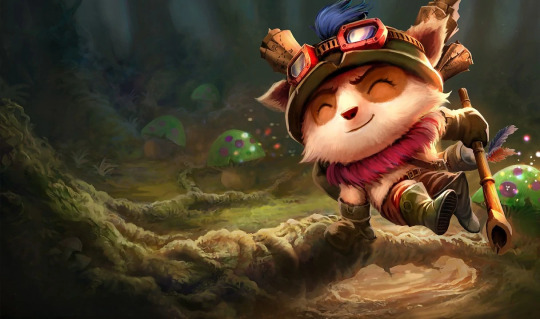
(Artwork by Riot Games)
So funny story: Teemo was originally going to be a Death Cleric and I had this massive joke about how “Illaoi was a Cleric with no Cleric levels and Lux should’ve been a Cleric but wasn’t and then the Devil himself ends up being a Cleric” but midway through writing this build I realized that another class made a lot more sense and I had to scrap like half my work.
Even on Tumblr Teemo annoys me.
GOALS
Swiftly - Teemo is literally called “the Swift Scout.” You’ll never guess what subclass we’re going to pick.
That's gotta sting - We’re going to need to fight dirty with poisons and blinds to overpower our foes.
Got a little surprise for 'em - Your enemies should never feel safe walking into your territory, knowing that a trap could be there just waiting for them.
RACE
One may think that to be a small Swift Scout one would want to be a halfling, but there are plenty of small races in 5e to choose from. This may come as a surprise but I’m actually going to suggest playing a Deep Gnome. Your Intelligence increases by 2 and you have Gnome Cunning for advantage on Intelligence, Wisdom, and Charisma saving throws against magic.
As a Deep Gnome your Dexterity increases by 1. You have Superior Darkvision of 120 feet, and advantage on Stealth checks to hide in rocky terrain thanks to Stone Camouflage. I mean, it’s not a bush but you could probably stealth in the jungle.
ABILITY SCORES
15; DEXTERITY - You don’t get the title of “The Swift Scout” by being slow on your feet. (Excluding the fact that you have 25 movement speed.)
14; INTELLIGENCE - Knowledge of guerilla warfare would be more intelligence-based.
13; WISDOM - Teemo is a survivalist, having to spend months in the jungle with nothing but mushrooms to keep him company.
12; CONSTITUTION - Even if Teemo is squishy in-game it’s still nice to have a bit of extra bulk.
10; STRENGTH - Teemo needs to be able to carry all his equipment, which is where Strength comes in.
8; CHARISMA - FUCKING TEEMOOOOOOOOOOOO. (Memes aside feel free to make your Strength lower I’m mostly just dumping Charisma for the meme.)
BACKGROUND
As a Survivalist the Outlander background is pretty good to take. You get proficiency in Athletics, but I’m actually going to suggest swapping your Survival proficiency with Medicine for reasons that are going to be clear later. Why Medicine? I think Teemo would remember to bring some health pots. Regardless you also get proficiency in a musical instrument of your choice (Spirit Blossom Teemo has a Flute so take that) and a language of your choice. (Which of course has to be Infernal kekw. But really pick whatever you think will be useful.)
As an Outlander your Wanderer feature will help you remember the layout of the map you’ve been on for 10 years, and you can find food and water for yourself and 5 other people due to your adept survival skills. Captain Teemo on duty!
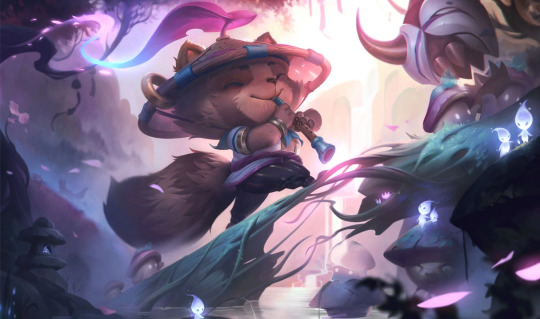
(Artwork by Riot Games)
THE BUILD
LEVEL 1 - ROGUE 1
Starting off as a Rogue for the extra proficiencies. Take Acrobatics to swiftly run away, Stealth to... well, stealth, Deception to trick foes into walking onto your mushrooms, and Perception to gain vision with your traps. You also get Expertise in two skills: Acrobatics and Stealth will make you the master of hit-and-run.
Speaking of hit-and-run Rogues get Sneak Attack, allowing them to do an extra d6 of damage if they attack with Advantage, or if an ally is within 5 feet of the target they’re attacking. The attack has to be with a ranged weapon which is a good segway to talk about Teemo’s weapon. Blowguns do exist in 5e but they’re trash, so unless your DM is willing to give you a seriously strong blowgun I’d personally suggest just using a Light Crossbow... for now.
But if you meet any other Bandle Scouts out in the wild you can communicate with them using Thieves’ Cant, a secret code only taught to scouts and other Rogues.
LEVEL 2 - ROGUE 2
Hey it’s everyone’s favorite ability: Cunning Action! As a Bonus Action you can now Move Quick to Dash or Disengage, or use your passive to Hide. Of course Hiding with Expertise in Stealth and then popping out to shoot a poisoned “dart” (crossbow bolt) at an enemy is a good way to get a sneak attack off.
LEVEL 3 - ROGUE 3
Third level Rogues can choose their Roguish Archetype, and hey isn’t it funny that Rogues have a subclass called “Scout?” Scout Rogues are Skirmishers, allowing them to move up to half their movement speed away from an enemy if they end their turn within 5 feet of you as a reaction.
And remember how I told you to drop Survival proficiency? Scout Rogues gain free Expertise in both Survival and Nature thanks to the Survivalist skill! Now would be a good time to point out that D&D Beyond will let you change the proficiency in your background if you get it past level 1. Also your Sneak Attack increases to 2d6.
LEVEL 4 - ROGUE 4
4th level is our first Ability Score Improvement: for some Guerrilla Warfare take the Skulker feat to hide more easily in bushes, not reveal yourself when you attack, and see better while hiding in the brush.
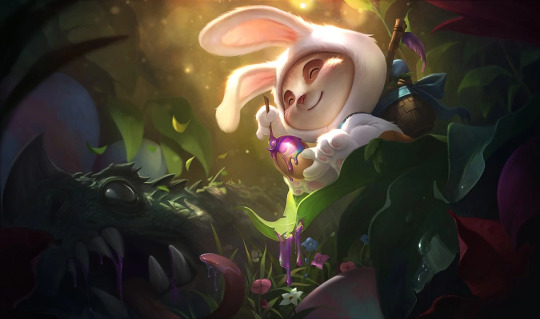
(Artwork by Riot Games)
LEVEL 5 - WIZARD 1
Hey look everyone it’s my favorite class, because Teemo perpetually frustrates me! If you can’t tell this was going to be Cleric levels and I’m writing this immediately after scrapping like half my build so... a little annoyed. Yay.
Anyways Wizards at level one get Spellcasting: you get a Spellbook where you can write down 3 cantrips and four 1st level spells. Your cantrips are always ready but you can prepare a number of spells equal to your Wizard level plus your Intelligence modifier. Seeing as your INT mod is 3 that means you can prepare all the spells I list! (At least for level 1)
CANTRIPS
For a ranged source of poison damage take Infestation to both poison and confuse your foes to make it harder for them to approach you.
For a melee source of poison damage take Poison Spray for a lot of damage! What do you mean Poison damage is commonly resisted? I don’t know what you’re talking about.
To strategize with your team Message will let you keep quiet while preparing to ambush!
SPELLS
Snare is a trap spell that will let set up a trap. Not a mushroom trap, but a snare trap.
If you want to use your traps for information however Alarm will let you ward an area so you know if someone passes through it. Or you can make the alarm loud so everyone knows!
For some poisoned darts Ray of Sickness lets you do... exactly that. Shoot posioned darts to poison your foes.
Finally to Move Quick take Longstrider, which increases your movement speed by 10.
You also get access to Arcane Recovery, allowing you to recover Spell Slots on a Short Rest equal to half your Wizard level rounded up (with some finer details please read the description of the ability that I’m too lazy to describe.) Teemo has a lot of supplies to survive in the wilderness, so it’s not surprising he packed more darts.
LEVEL 6 - WIZARD 2
Second level Wizards can choose their Arcane Tradition and I’m actually going to suggest a bit of a wild card here: go for the Bladesinging subclass. Yes it’s meant for Elves only but I have never met a single DM who enforced that rule.
Regardless as a Bladesinger you have Training in War and Song for Performance proficiency, Light Armor proficiency (which you already have), and proficiency in one type of one-handed melee weapon. (Scimitars are the only Finesse weapon you don’t have proficiency in as a Rogue so that’s basically your only option.)
But the main feature of the Bladesinger is of course their Bladesong. You can activate your Bladesong as a bonus action for 1 minute. During Bladesong your AC increases equal to your Intelligence modifier, your walking speed increases by 10 feet, you have advantage on Acrobatics checks, and you get a bonus to Concentration checks equal to your Intelligence modifier.
“But Teemo doesn’t use a sword!” I hear you say. Well Bladesong ends if you use two hands to make an attack but you know what doesn’t take two hands to shoot? Well for one Blowguns, but since Blowguns in 5e suck: Hand crossbows! Get a Hand Crossbow to supplement a blowgun, and boom you’re still a ranged character! Yeah much to my surprise Bladesinger doesn’t have any restriction on using ranged weapons: you just can’t use two hands to make an attack. Regardless you have two uses of Bladesong per short or long rest.
You can also add two more first level spells to your spellbook like Detect Magic and Identify to help you know what you find in the wild.
LEVEL 7 - WIZARD 3
Third level Wizards can learn second level spells like Blindness / Deafness for a blinding dart, and Invisibility for more Guerrilla Warfare.
LEVEL 8 - WIZARD 4
4th level Wizards get another Ability Score Improvement but you know what we don’t have enough of? Feats! Take the Crossbow Expert feat to ignore the loading property on crossbows, ignore melee range disadvantage with crossbows, and attack with a hand crossbow with your bonus action after making the attack action. Stinger attack speed’s gotta sting!
Additionally you can learn another two spells at this level along with a new cantrip! For your leveled spells grab Misty Step for Flash and Enlarge / Reduce, because size doesn’t mean everything. For your cantrip Mending will help you keep your scout equipment in check.
LEVEL 9 - WIZARD 5
At level 5 you can learn 3rd level spells. You know what we haven’t gotten yet? Mushrooms. For a very expensive trap Glyph of Warding will let you put down a near-invisible glyph in an area for a mere 200 gold and 1 hour of set-up time. You decide what triggers the glyph, be it something complicated or something simple like an enemy walking near it.
When the spell activates you can choose one of two effects: the simple solution is just to make it explode for 5d8 acid, cold, fire, lightning, or thunder damage. Alternatively you could store a spell of third level or lower into it, and have it target whoever activates the glyph or the area around them. I’d highly suggest reading Glyph of Warding over in full before using the spell. It’s a powerful spell but it’s costly and requires a lot of set up time.
But you know what’s a simple spell? Fireball. Weaponize your shrooms for a big explosion of damage.
LEVEL 10 - WIZARD 6
6th level Bladesingers get an Extra Attack! Yup: that’s it! Because you’re a fake Fighter. But yeah this is primarily why we took Crossbow Expert, so you can still attack twice with a crossbow.
Well, you can also add another two spells to your spellbook. To move incredibly Swiftly take Haste. Other than that you can truly grab whatever spell you want as there isn’t much else that’s truly “in character” for such a simple character as Teemo. My out-of-character suggestion is to take Mirror Image from second level for a great boost to survivability. The only thing more annoying than one Teemo is three Teemos.

(Artwork by Riot Games)
LEVEL 11 - ROGUE 5
Back to our swift scouting ways 5th level Rogues get Uncanny Dodge, letting them use their reaction to reduce the damage of an attack by half. Your Sneak Attack damage also increases to 3d6.
LEVEL 12 - ROGUE 6
6th level Rogues get Expertise in two more skills: Perception will let you make good use of your wards, and Deception will let you make good use of your mushrooms.
LEVEL 13 - ROGUE 7
Isn’t Teemo really annoying and hard to kill? Well with Evasion he’ll be even harder to kill since he’ll take no damage on a successful Dexterity saving throw and only half damage if he fails. And your Sneak Attack increases to 4d6 too?!
LEVEL 14 - ROGUE 8
8th level Rogues get another Ability Score Improvement and you know: I don’t think we have enough Feats. Fade Away is a Gnome-specific feat that will let you get use out of your passive by turning invisible when you get hit as a reaction. You remain invisible until the end of your next turn or until you attack, deal damage, or force someone to make a saving throw. You can use this reaction once per short or long rest and it uses the same reaction as Uncanny Dodge, so use it wisely!
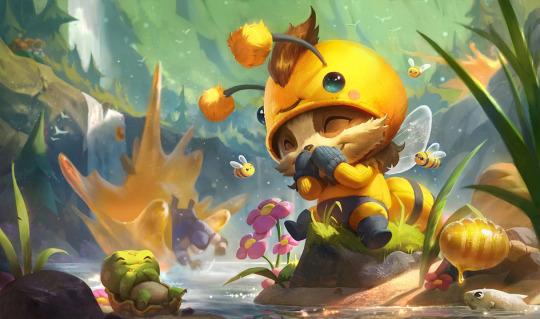
(Artwork by Riot Games)
LEVEL 15 - ROGUE 9
At 9th level your Scout training gives you Superior Mobility for 10 extra feet of movement speed. "Hut, two, three, four!" Your Sneak Attack damage also increases to 5d6.
LEVEL 16 - ROGUE 10
10th level Rogues get another Ability Score Improvement to help compensate for all the feats. Increase your Dexterity and Wisdom by 1 for even Ability Scores.
LEVEL 17 - ROGUE 11
11th level Rogues get Reliable Talent so any roll with a skill you’re proficient in can’t be below a 10. If you roll a 9 or lower it counts as a 10. Whenever I get this ability I like to do a tally of all the skills you have and what the lowest potential roll is, so...
26 in Acrobatics (with Advantage if in Bladesong)
26 in Stealth (with Advantage to hide in rocky areas)
25 in Nature
24 in Perception or Survival
22 in Deception
18 in Medicine
16 in Athletics
15 in Performance
And to top it off your Sneak Attack damage increases to 6d6.
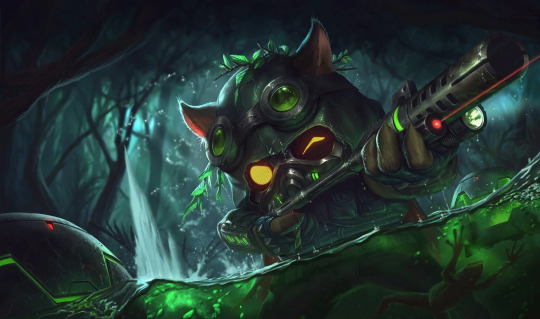
(Artwork by Riot Games)
LEVEL 18 - ROGUE 12
12th level Rogues get another Ability Score Improvement and as much as I want to take more Feats (believe me I do) let’s finally cap off that Dexterity score for the deadliest darts.
If you aren’t playing with Standard Array and want some more Feats here’s a few I could suggest:
Poisoner (Yeah duh)
Svirfneblin Magic (More blinds, among other things)
Alert (To always be ready for a fight)
Observant (A half feat to spot any incoming danger)
Tough (Just because you aren’t a tank doesn’t mean that Grasp of the Undying is a bad rune)
LEVEL 19 - ROGUE 13
With 13 levels in Scout you are an Ambush Master. You have advantage on initiative checks, and in addition the first creature you hit during the first round of a combat becomes easier to hit. Attack rolls against that target have advantage until the start of your next turn, because it’s pretty hard to defend yourself when blinded. "Smell that? That's fear." Your Sneak Attack also increases to 7d6.
LEVEL 20 - ROGUE 14
Your final level is the 14th level of Rogue for a 10 foot Blindsense, allowing you to sense any hidden or invisible creature near you. Clearly they only have camouflage.
FINAL BUILD
PROS
Turns out I got a proficiency in killing - Up to three attacks per turn with a +11 to hit means it’s more than likely you’ll hit your 7d6 Sneak Attack. Not to mention the strength of Wizard spells, notably Fireball.
Wars are won with men, not machines - Rogues are skill monkies and it turns out you’re quite the asset outside of combat. Expertise in 6 skills, notably the ones to keep alive in the wilderness. And of course the ability to cast Ritual spells like Detect Magic and Identitfy.
Never underestimate the power of the Scout's code - So Teemo’s pretty annoying right? Well I didn’t realize he’d be so damn elusive! +11 to Dexterity saves with Evasion, 35 feet of movement, Advantage on all mental saves, insanely good stealth skills, reactions to get away from danger... And this isn’t even mentioning the benefits from being a Wizard! Bladesong lets you increase your AC by 3 (up to 20 if you’re wearing Studded Leather!) and increase your movement speed to 45... Oh and you can just turn invisible! As well as blind the enemy and speed yourself up.
CONS
Size is a liability - A few feats too many means not enough ability scores, yet somehow we don’t have enough feats for things like Poisoner. Perhaps reserve this build for when you can use Point Buy. Or at least ditch Skulker because you really don’t need it when you can, ya know... turn invisible?
You'd be surprised how quick fur ignites - Of course the lack of Ability Scores means that your Wizard DC isn’t fantastic. Granted most of your spells are utility but a lot of them require saves, and a lot more of them are rather weak. Poison damage is one of the worst damage types in the game and both your cantrips are poison, not to mention Ray of Sickness. Feel free to grab other spells as you see fit.
Lots to do before I punch out - Teemo is squishy in League and Wizard levels don’t help in D&D. Even with the +1 to CON you’ll likely have a little over 100 health by level 20, which easily puts you in Power Word Kill range. You’re elusive yes but a bit of bad luck and you’ll be six feet under.
But you’re not meant to be the strongest: you’re meant to be annoying. Hit-and-run, hide in the shadows, and whittle the enemy down before you win the war of attrition. You’re in it for the long-con, and not just the end game. You’re engaging in psychological warfare: tearing at your opponent’s mental state until nothing remains. You are a master of anger and temptation. You are a demon; a devil... Or you might just be a hamster with a blow gun.
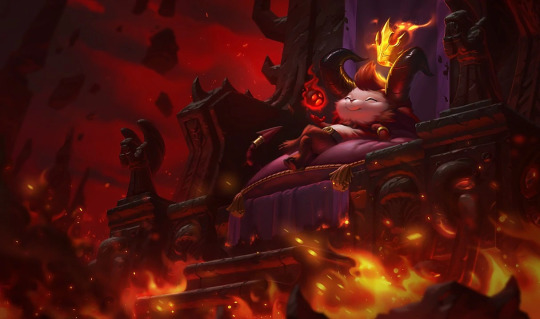
(Artwork by Riot Games)
#DnD 5e#dnd#dnd build#dnd guide#League of Legends#League of Legends Teemo#dnd rogue#dnd wizard#satan
9 notes
·
View notes
Note
How do you feel about the quality of new Artificer? I've always wanted to play that type of character but the weird focus on gimmick minions as the big feature for both subclasses kind of bugs me. Giving it extra attack but having the only guaranteed martial proficiencies be crossbows is also strange mechanically, if thematically appropriate.
I don’t really like it much, which hurts, because I love alchemists, gageteers, and crafting, and I want them to work. But at it’s core, the 5e design team shot themselves in the foot by not putting any effort into crafting systems or even decent and consistent item pricing, which forces any artificer class to have an uphill battle against DM fiat. No other class really depends on the DM being extremely permissive and pro-creativity.
So this version gets a cool “Prestidigitation/Thaumaturgy” cantrip analogue, despite also having Prestidigitation as a cantrip. I don’t like the strange way that you have to deactivate the earliest effect rather than any that you want, which makes it feel like you’re cycling through a batch of traits. The timing issues here seem kind of pointless, since you’ll never do these things in combat, anyway.
The half-caster spell list is uninspiring, but much better than the third-casting of the original document, without the power of the fighter or rogue chassis that the Eldritch Knight and Arcane Trickster could fall back on. That was an absolutely boneheaded mistake. But this isn’t great either, especially since it simply tells you to cast a bunch of standard spells, but just kind of pretend you’re using a gadget. Boring and lazy as hell, and they’ve been working on this for two years.
They get multiattack, but require it to be a magic weapon, which is strange, but ties into the only interesting spell choice, Arcane Weapon, which adds 1d6 magic damage (your type choice) and makes a weapon magical. Very powerful for a 1st level spell, despite the concentration, and basically makes Magic Weapon look like an even bigger piece of shit. I can see valour bards stealing this. This is one of those spells like Find Familiar, Hunter’s Mark, Hex, Find (Greater) Steed, Spiritual Weapon, and Eldritch Blast that is a hidden class feature in spell form.
The Right Cantrip for the job is cool but strange; this kind of flexibility with cantrips feels like it should have been a sorcerer ability.
Spell Storing is the real stand-out here, because giving your, say, fighter or rogue a spell to cast and maintain with their otherwise untouched concentration slot is an absolutely amazing force multiplier. Letting your fighter cast Arcane Weapon, Haste, Enlarge/Reduce, Dispel Magic, Fly, and Revivify while you cast your own spells can be game changers. (Arcane Weapon alone on an 11th level fighter is pumping out an extra 3d6 damage a round)
Soul of Artifice might also be the best 20th level capstone ability in the game, rivaling the Barbarian’s stat boosts.
So onto the Alchemist.
And yeah, for some reason the design team refuses to really let pet classes scale well. There’s some scaling here, in HP, but everything else is static and it’s going to fall behind terribly after a while and really could have been replicated with Find Familiar or a special, low level casting of Create Homunculus. At least you can effortlessly revive and restore it to full health, since it will die. Constantly. Functionally, you can milk it three times a day for a slow fly speed, temporary HP, and a roll advantage. That’s always going to be useful.
Alchemical Mastery is a casting of Lesser Restoration and a flat +Int bonus (so you’re going to plateau at +5) to HP restored or Acid/Fire damage as a bonus action. Unfortunately, this also destroys the Homunculus’ weak combat power, as its 1d6+2 damage is pointless when you could just deal +5 damage on a more likely to hit cantrip.
Chemical Savant gives you acid and poison resistance, because being smart increases the bond of your hydrogen atoms and brings you closer to the glory of the Yuan-Ti (and dwarves). Poison is a common damage type, but this is a frequent racial feature, and acid damage isn’t particularly common unless your DM has a vore fetish (so all DMs). You also get a free Greater Restoration once-per-rest, which is very nice.
Pretty boring subclass, to be honest, which doesn’t scale and all. You seem to get relatively weaker as you level, which is strange. Adding Proficiency to some bonuses could help with this.
Artillerist is strange, and I wonder why it was chosen over tweaking the Thundercannon. Alchemy is ancient. Firearms like the handcannon and arquebus actually predate the rapier, and cannons are 15th century weapons faced by the likes of Joan of Arc, but semi-static, man-portable artillery pieces like this only pop-up with the Armstrong Gun and are hard to fit in many fantasy worlds. The scuttling robot crab legs go on to push it into completely different genre-territory. There are multiple tactical considerations here as well, as gun emplacements are a rather new concept in D&D.
The gun itself takes some time to set up - with a full action to summon, like you’re a Protoss - but only needs a bonus action afterwards. Unfortunately, it starts off incredibly powerful at 3rd-5th level but doesn’t scale beyond your improved Intelligence score (which will likely only be an increase from +3 to +5 across your entire character’s lifepsan). The inability to change what the turret does without spending a full action also sucks.It takes until 14th level for this power plateau to change, when Fortified Position comes online and you can summon two turrets and it starts passively generating half-cover (so +2 AC and to dex saves) with a magical field in a 10′ radius. Also, it isn’t described, but it seems likely that a rock gnome, both the best artillerist mechanically and flavorwise, can actually mount the damn thing. Wonder how it interacts with the Mounted Combatant feat.
So basically, starts off very strong, before starting to suck between 5th and 13th level, afterwhich it becomes a strong source of AC, save boosts, and temporary HP.
Considering the power of wands, however, the real buy-in here is crafting wands at a quarter of the price. And if wands had prices in the DGM, that would have been really cool. At 6th level, you can infuse a wand with a cantrip (later, two), but due to the wording, only you can use the wand, so it’s just a free artificer cantrip for you with +Int Modifier damage rather than a Firebolt on a stick that you could hand off to an NPC hireling for extra damage. This especially sucks since core artificer already gets a cantrip-swapping ability. This is, quite frankly, the dumbest fucking design idea since SCAG gave half-elves the option to trade any two skills for perception. When a player picks an artificer, they want to be able to make cool devices that they can also give to people. Because that’s what a device is. If the device is bound to you mechanically like this, it doesn’t feel like a device.
You also get 10 free permanently prepared blast and wall spells, which is hilariously two-thirds of what a sorcerer can ever know, ever. Fuck those guys.
Finally come the Infusions.
Boots of the Winding Path lets you teleport back to a space you just were, and…OK, Torbjorn, now Tracer.
Enhance Defense and Weapons as +1 and later 2 AC and weapon bonuses. Powerful, expected. Radiant weapon is a powerboost to this, with light and a dangerous blind effect, and returning weapon is a boomerang effect on a thrown weapon. Resistant armor grants an elemental resistance to armor.
Many-Handed Pouch is really flavorful, a collective pouch with many openings, perfect for sleight-of-hand shennanigans. This is my favorite of the infusions. It isn’t particularly strong, but it’s cool and creative.
Repilcate magic item is incredibly powerful, and feels like the ONLY power source of the class at high levels. But my God this can probably get crazy, with 5 attuned magic items. Winged Boots, Bracers of Archery, Amulet of Health, Belt of Hill Giant Strength, Cloak of Elvenkind, and Arcane Weapon on a +2 weapon can basically turn you into an ersatz ranger or grab-and-drop grappler. I also don’t know if the DMG should be this player-facing.
All in all though, it feels like a step back from the cleaner, tighter original version of the artificer, and I would really prefer to chop it up and give item crafting to everyone with the old formula system. Personally, if I wanted to play an alchemist character, I’d just tell my DM I was going to tweak the flavor of a wizard and/or knowledge cleric (k. cleric 1/wizard is a good alchemist kludge). I simply don’t think a crafting class can function with the core assumption, gameplay styles, and rather, uh, let’s say listless design team of 5e.
17 notes
·
View notes
Text
20 Dungeons and Dragons Asks
So I have been asked to answer ALL of the following questions by @the-name-ofthe-wind (thank you btw) and so I will do so now.
1. What was the first race you ever played as?
The first race I ever played as was drow.
2. What was the first class you ever played as?
First class I ever played as was the fiend pact tomelock, though I later multi classed into necromancer.
3. Have you ever been dungeon master?
Yes! I have only played for about three years now, but in that time I have been a DM for many campaigns, one shots, and more. In fact, I think I might have DMed more games then I’ve played.
4. How many times have you been dungeon master?
To be honest, I have lost count. However I would say more than ten games.
5. What is your favorite race?
My favorite race is still drow. I have tried others but the drow’s skills and ability score increases just match my favorite build perfectly and it really fits my usual playstyle.
6. What is your favorite class?
Warlock continues to be my favorite, though wizard and cleric are close seconds.
7. When was the last time you played d&d?
Five days ago. And I’m playing again tonight and tomorrow night.
8. Do you prefer theater of the mind or minis and grids?
I’m kind of on the fence with this one. I usually use theater of the mind myself, but I’ll sometimes switch over to minis and grids if I feel it’d work better in that given scenario.
9. What is the funniest thing anyone has ever said in a d&d session you’ve played in?
“I don’t know about you guys, but so far I’ve been skewered by fish people, stepped on by golems, been hit by our own wizard’s spells, been kicked down a flight of stairs, and just now I broke a nail. I don't care how much we’re getting paid for this job anymore. I’m going home.” - Thomas Deadfoot
10. What is the most annoying thing that has happened during a d&d session you’ve played in?
One of the rogues in the first campaign I was ever in got tired of his character. However, rather than retire the character he wanted to see how much drama he could cause before infighting broke out. After he accomplished that, he tried to kill of my character, bankrupt the guild, and cause a TPK just because playing his current character got a little boring. Like seriously? Just retire the character and make a new one. Don’t ruin the game for everyone else.
11. What is your favorite edition of d&d?
I have only ever played 5e but my step-mother got me 1e this past Christmas and I want to try out 3.5 once I get the chance.
12. What is your favorite 5e book?
I’m a lore fanatic so I really like the Sword Coast Adventurer’s Guide because it holds a lot of information on the world of Faerûn.
13. How many d&d characters have you made?
More than I can count (I make my own NPCs when I DM), but by characters I’ve made and played as I’d have to say about ten.
14. What is the longest d&d campaign you have ever been part of?
There’s one campaign I DMed this past year and it lasted for about 8 months. We’re still not done, but we all decided to take a break and play through the Tyranny of Dragons campaign before returning to the first one. Once we return to the first one and complete it it’ll have been a 16 month campaign, which will be the longest one i’ve done.
15. What is your favorite weapon?
Rapier, though I also really like the quarterstaff and longsword.
16. What is your favorite spell?
It’s a tough choice between Animate Dead and Fireball.
17. What is your favorite armor?
Breastplate, though I usually end up using studded.
18. What level do you usually start your players at?
Depends on the campaign, but most I’ve run have started anywhere between 1 and 8.
19.What level do you as a player prefer to start as?
I like to start anywhere between 1 and 8. Anywhere higher than that and I feel like we lost out on the early level struggles and I like those.
20. Do you like to play in big or small groups?
Any group between 4 and 10 players in person is fine by me. However with an online group I try to keep it at a max of six.
#dungeon master#dnd player#dnd character#dnd 5e#dnd quotes#dungeonsanddragons#dungeons and dragons#ask game
4 notes
·
View notes
Text
Musings: A look at the OSR - Part II: Love the presentation, come to hate the rules
There’s countless people out there who cut their teeth on Classic Dungeons & Dragons (”little brown books” plus supplements, OD&D, Oe, 0e), Basic D&D (Holmes Basic, B/X, BECMI) or Advanced D&D (1e). And a lot of present day OSR games emulate these, for example OSRIC (1e), Astonishing Swordsmen & Sorcerers of Hyperborea (1e), Swords & Wizardry (0e), Labyrinth Lord (Basic), BLUEHOLME (Holmes Basic), and so on. Some of these were specifically written to provide reference game systems to write for to retain compatibility with earlier editions of D&D without having to reference the D&D name or out-of-print products. Especially Labyrinth Lord. The basic releases of Swords and Wizardry integrate either only the original White Box, or also Supplement 1, or all supplements released for 0e. But these games also have been polished, unified, cleaned up, and updated a bit. S&W features support for ascending armor class, a feature introduced to D&D no sooner than 3rd edition. These games stay true to their preferred editions in most ways, while also providing a bit more streamlined experience than you might expect from 0e (where you had to construct your own game out of all released material and home rules) or Basic (where material was distributed across boxes and level-limited, and some material got never published before another, contradicting new line was released).
What they have in common is that they are labors of love of a devoted fanbase who enjoy D&D gameplay, consider D&D their favorite game or even only game of choice, and who devote significant time to playing it, writing for it, and refining it.
The art is often a callback to earlier editions. I feel right at home with black-and-white line art. It gives me a cozy feeling and evokes the fantastic for me. The rules... not so.
The capabilities of D&D characters don’t seem so fantastic in earlier editions, there’s a long, arduous grind to go up in level, and not much is gained. Magic gear is where it’s at. What can a mid-level S&W Complete Fighter do? He can multi-attack mobs of pitiful monsters, is harder to hit if dextrous, is the only one who gets strength boni, can hit better, and has more hit points. He eventually gets to have a stronghold. If you look for a reason why there’s such a variety of magical swords back in the day, look no further.
This is not truly a surprise. The D&D character as we know it evolved out of Dave Arneson’s wargaming group. Arneson wasn’t a great rules writer or editor, but his group pioneered advancing by level because they moved away from one-shot encounters with meaningless pawns to keeping continuity for their chosen avatars. Frankly, players didn’t like seeing them dying, so they were given increased capability to increase survivability. (Don’t expect any Gygax fanboy-ing from me, I pretty much think Arneson invented the actual game and Gygax wrote the first ruleset for it. I’m not happy with all the “Gygax this” or “Gygax that” which - to me - seems to be endemic in the American player base. If I have to “worship” an individual “hero” or “titan” over everybody else, Arneson would be my pick. But frankly, I would rather not. I respect both and their legacy.)
And early D&D reflects this legacy in that characters are more capable than their fantasy wargame antecedents, but not very fantastic or awesome, really. I personally am just fine with the short time 5th edition let’s pass between level 1 and level 3 and the range of capabilities a 5e character can have. If somebody tells me they needed 10 years or more to get to level X and that is the right pace and was still an accomplishment, I gag a little. Because time is getting scarce, players are not necessarily easy to find, and there’s precious few opting for a punishing game. I love many things about the older editions but I consider a lot of it “a work in progress.” I appreciate the “use it as you want and extend it, it’s your game” culture ideals of 0e which seemed to come to lessen with 1e... a lot. I do appreciate the raw creativity of building fantastic worlds for the first time, no matter how eclectic, slapped together, improvised. But I tried to run games that are true to what some people believe to be the punishing ideal of gaming, and players ran for the hills.
You could blame computer games and their ever-evolving power fantasies. But many people have come forward and shown that computer games in turn owe the idea to an extent also to D&D. The chickens have simply come home to roost. History cannot be dialed back. And it shows. And why shouldn’t it? D&D was often a power trip in the first place. It just got “trippier” over the years.
Now, I’m not saying that you could not run a fantastic game with these rulesets and materials out of the box. You can. But it will depend on your charisma, inventiveness, and sheer skill as GM to actually sell these games today to new players. It can work, of course, and it can be great fun. I’m not denying that. But I’m not so sure why I should try to sell that in the first place?
Compatibility with old material is a great plus. There’s tons of existing material out there, especially starting with 1st edition or AD&D. But frankly, I hate AD&D. I have it standing on my shelf and I feel like it’s not a good ruleset. AD&D2 has it beat in my opinion. I’m not a big fan of Gary Gygax, rules designer. Gary Gygax the creator of adventures and evocative prose... that’s a different thing. Frankly, I am not a fan of where 1e tried to wander - into this semi-simulationist territory. I can do very well with a game that understands that it is merely a game and that complexity needs a well-defined pay-off.
In fact, in comparison the 1st edition Players Handbook and Dungeon Masters Guide are both examples of lots of mini-rule-systems thrown together. Whatever Gygax could think of he foisted his own rule-systems on. And they lack in coherency. A lot. You also cannot play the game without the DMG - because even the actual to-hit matrices of player characters are hidden in that tome. I tried to like this game. I really did. It’s a disaster. People keep singing its praises but I’m not sure you can put these three books - including the Monster Manual, of course - into the hands of most 20-year-olds with an interest in roleplaying and expect them to like this stuff and starting to play. The legend of 1e lives on because the players who started with 1e (or spent a long time with it) live on.
None of those specific games I mentioned truly dare to transcend the original rulesets. Fixes. Unification attempts. It’s all in there. But there’s also “d100 for this” and “d20 for that” and “roll high for this” and “roll low for that”. That persists. Action resolution is a mixed bag of separate rule systems and little engines. It’s a replication of the rules more than anything else.
I find it funny because one of the OSR mantras is “Rulings, not rules.” Placing authority in the hand of the GM to rule individual situations from deliberating this instance (or set of instances) instead of relying on a fixed set of rules. But these games come with rules! They are just... messy, unnecessarily complex in some cases, underdefined in others, lack design or coherence. So, GM help yourself! No wonder there’s so many fantasy heartbreakers out there... People love playing D&D, but it’s hard to ignore there’s some - or many - things in there that need fixing! So they fixed and released and fixed and released.
And so did the owners of the D&D trademarks and copyrights. The game changed. Monster-killing became more important. But it’s not like many players already hadn’t thought that most of the time. It comes with a book full of monsters, after all. Player character capabilities increased. Rules were streamlined, unified. Not all for the better. I don’t exactly prefer Pathfinder’s heap of feats and 4e’s oodles of class powers to 1e or 2e or Basic. But I recognize that these newer games come with more deeply unified engines.
How powerful a unified engine truly is can be seen in games like Dungeon Crawl Classics (which has a streamlined 3e under its hood, then grafted lots of tables on it) and... 5e. I like 5e. I’m really glad this edition came out because I like both the old school and new rules. And 5e came somewhere in between, if not perfectly then at least it tried. Because all the “d100 here” vs “d6 here” and “d20 high here” and “d20 low here” and their endless variations... I can’t be bothered with. Not truly. Not for long.
Because I love the old school feel. Not the rules. I suspect something like the Black Hack is more up my alley than 1e. I know Dungeon World definitely is. I have tried. I keep buying OSR material. But I don’t really get warm with the rules. I don’t feel “converted.” The rules of old D&D were a worthy first try. The game once was meant to evolve with the needs of the GM and the players. Instead the rules... stuck. At least for some. I personally see that as one of the unluckiest inversions. I think it was never meant to be.
And I’m happy every time somebody makes a new riff on D&D without simply going back. Kevin Crawford’s “Scarlet Heroes” is foremost on my mind. Moving towards elegance, simplicity, honoring the spirit of the game.
(to be continued)
1 note
·
View note
Text
Campaign Entry #6
To those of you who follow my campaign entries, greetings, it fills me with great honor to those who take their time to read these entry logs. This week’s entry I hope to explain a few things more easily and do a quick summary of my entries. It has been brought to question if there are any “concrete” rules to D&D; the answer to that is yes. Just like any game, especially a complex role playing like D&D there will always be a set of rules. These rules though are long and complex to explain, but they can be found in both mainly The Player’s Handbook and in the Dungeon Master’s Guide. (Bellow will be the link providing a PDF version of the handbook if any wish to view them.)
The Player’s Handbook (5th Edition): https://dnd.rem.uz/5e%20D%26D%20Books/D%26D%205e%20-%20Players%20Handbook%20(Small).pdf

Do note however that these are the basic fundamentals of the game. There are extensions and other books that will add on new game rules for additional content. And that’s only just for this version of D&D I play in, otherwise known as 5th Edition. The world of D&D over the years has grown and expanded, with new material adding over the year as well. If you were to compare 5th Edition to the Original (i.e. 1st Edition) while there are similarities, there is a vast difference between them. Especially when 5th Edition is still pretty new, having been released in 2014. So in terms of rules, depending on which of the editions you play in there are concrete rules.
But even with rules there are... leeway's, for lack of a better term. This goes back to my earlier campaign entry explaining about Classes. Every class has a boon and fault to them. Some are stronger than others and some, admittedly, have the most ridiculous abilities that when observed in person they will make you go “WTF!!!”

An example would be the Rogue class, in terms of power, they’re average; having average AC between 14-16, and using more finesse like weapons such as knifes and rapier like weapons that deal about 4-8 points of damage max (and that’s without adding any bonus that may go along with it). Now granted, I’m not all entirely familiar with the Rogue class myself, but I do know that under special circumstances, they can deal up to 30 points of damage!!! (The average damage from just one attack ranges between 5-11, 15-18 damage are hard and sometimes the most done for some classes) This circumstance will be what is called a sneak attack; now anyone can do sneak attack, but by the nature of Rogue’s (i.e. Assassins, Thieves, Spies) they have a unique ability and feature that makes it so that they deal massive damage when performing sneaks attacks. And that’s just for Rogues, every Class has something unique to them that gives them just the right amount of edge to deal a massive attack to whatever they’re fighting.
But that’s just only already established featured abilities, abilities that need to activate under the right type of circumstances. As for the leeways as mentioned, say you have gained a weapon or spell and you have a creative way of using it, HOWEVER... by the wording of the rules it can only be used in a certain manner that doesn’t match how you wish to use it in your creative manner. But you want to use it really badly in your idea, what do you do? You try to convince your DM into allowing this to happen. Make the most compelling, persuasive argument you can imagine, more so than when you do a last-minute-self-induced-caffeine-rush assignment due in 10 minutes and you only started 30 minutes before the deadline. If you convinced them, then you are allowed for either that one instance for which you wish to use it for, or for certain cases just like any other featured abilities, so long though as it follows the rules and doesn’t break them too much that it would be seen as if you’re cheating. But again, it can only be allowed with the DM’s permission.

Another thing brought to question are the use of the Dices. There are 7 dices in the game that can be used. Ranging from a 20 sided, a 12 sided, two 10 sided, one 8 sided, a standard 6 sided die and one 4 sided die. The most important however will be the 20 sided die (or as I personally called the Die of Fate). As this die helps determine whether or not certain actions are followed through. For instance, let’s say you’re fighting a Minotaur of 16 AC and you have a Strength of 14, this gives you a +2 modifier. If you want to hit the Minotaur you roll the 20 sided die and must match the the Minotaur’s 16 in order to hit, meaning with your +2 modifier you need a minimum of 14 to hit it (you add the number you roll with your modifier to determine the power behind your attack, in this case 14+2 to equal 16).
As for the rest of the dices, they can be used to determine the amount of damage given to the target you hit or are hit by, as well as the amount of health you have. If you were to hit a target with fist or a knife, you would use a d4 (4 sided die) to determine the damage. If you used a longsword as your choice of attack, you would roll a d12. Even spells use dice to determine damage, such as shooting a projectile of fire missiles, you would use 3d6 (three 6 sided dice) to determine the damage. With the exceptions of spells you can also add your modifier to the damage you give, so using your previous example of +2 if you were to roll an 8 with the longsword, you would deal 10 points of damage instead. Although certain weapons labeled as finesse weapons can use either Strength or Dexterity as a modifier, so if your Dexterity was better than your Strength and your weapon was finesse (knife or rapier for example) you can use your Dexterity to gain both a better chance to hit and deal damage.

And in terms of determining your health, it depends on your class. Each class will automatically have a die assigned to them that determines how much Life/Hit Points they have at the beginning and later on. For Fighters and Warlocks, they are given the 10 sided die and 8 sided die respectively as their HP. Also if their Constitution was a 12 that would give them a modifier of +1, add the Constitution to the die at first level, they would have 11 and 9 HP respectively to start out with. But upon leveling up beyond 1st level, you would roll the die to determine by how much it increases by along with the +1 Constitution modifier. So if both rolled a 5 they gain 6 HP, increasing their HP to 17 and 15. The d4 however is the only die in the game that is not used to determine a character’s HP. That’s it for now, for any more clarification about D&D feel free to ask.
Until next time, farewell fellow adventurers.
1 note
·
View note
Text
5e Senna the Redeemer build (League of Legends)
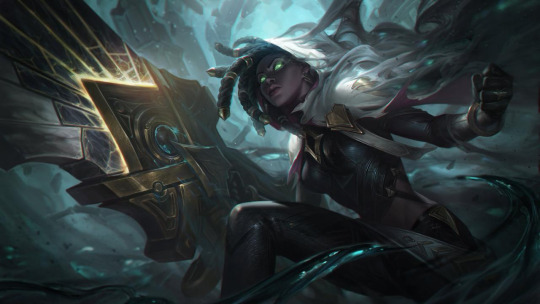
(Artwork by Riot Games)
Friendship ended with Xayah and Rakan; Senna and Lucian new best LoL couple.
I really don’t have much to say on why I wanted to make a Senna build other than “she’s cool and Lucian has best girl.” But seriously can we talk about how hype Senna’s release was? Lucian was fighting for SIX YEARS to get his wife back and then... he did. Senna’s trailer honestly made me shed a tear I felt so happy for the guy.
GOALS
Light - Senna is the redeemer of lost souls, and fights along with Lucian in Sentinels of Light. Naturally she needs some divine Damacian protection at her side.
And Darkness - Her time in the lantern has given Senna some lasting changes. She can turn into a screaming cloud, among other things.
Be free... - Senna seeks to set the lost souls of the Shadow Isles free, and also uses her powers of light and darkness to keep her allies alive.
RACE
Senna is a human but all that time in Thresh’s lantern has changed her quite a bit. Normally I’d just go for a Variant Human but I thought we should spice things up a bit: the Mark of Finding from Eberron is perfect for a Survivalist who spent their life running through a soul-filled lantern. Your Wisdom score increases by 2 and your Constitution score increases by 1, and unlike most humans you start with a Darkvision of 60 feet from all the time you spent in the darkness of a... lantern. Thresh you want to fix the light in there?
But the main skill you gained in there was Hunter’s Intuition. If you roll a Perception or Survival check you can add a d4 to the roll: note that this does stack with spells like Guidance for quite a bit of insurance when trying to spot a lost soul or survive in a realm full of them.
You also get access to Finder’s Magic which just gives you a big ol’ list of spells along with some innate spellcasting. I’ll cover all the spells you get when you’re at a level to cast them in the build. You also know Common as well as Goblin. "Yeah, I met someone in there. He's a ghoul goblin. We fell in love and made ghoul goblin babies..."
If your DM doesn’t allow Eberron: Feel free to play a Variant Human. Increase your Dexterity and Wisdom by 1. Take any skill you want (I’d argue Religion would be in-character) as well as any language you want and take the Sharpshooter feat for more accurate shots with your relic cannon.
Also for whatever reason the Spells of the Mark don’t appear on the D&D Beyond virtual character sheet, so I’ve elected to not mention them in this build.
ABILITY SCORES
15; DEXTERITY - Running all your life from the terrors in the mist takes a lot of dodging skill, and while that Relic Cannon might weigh a lot it takes Dexterity to aim it.
14; WISDOM - To fight with both the light and dark you don’t need brains; you need sympathy.
13; CONSTITUTION - Senna herself says that The Mist is like you’re drowning. You ever held your breath for 6 years? I don’t think so. Also this is mainly to balance the +1 to CON from Mark of Finding.
12; INTELLIGENCE - You’re the brains of the operation, even if Lucian doesn’t want to admit it.
10; CHARISMA - Senna is best described as “rough around the edges.”
8; STRENGTH - Even though your Relic Cannon weighs a ton I’ll chock that up to the Curse of the Black Mist more than Senna’s actual upper body strength.
BACKGROUND
Even at a young age Senna was corrupted by the Black Mist, and the Haunted One background from Curse of Strahd is for those with a dark past. You choose 2 proficencies from the listed skills: take Religion and Survival for training both as a Sentinel of Light and as a survivor of the Shadow Isles. You also get one exotic language and while I always suggest to take what you think will be useful Deep Speech is likely the most common language of the creatures of the mist.
As a Haunted One you get a Heart of Darkness. A look into your green eyes will reveal a tragic past, and will influence the local priest to help you and possibly hook you up with his son. Commoners will be able to tell that you have a tragic past and will do anything to help you, even helping you fight if your old warden corners you when you’re alone.
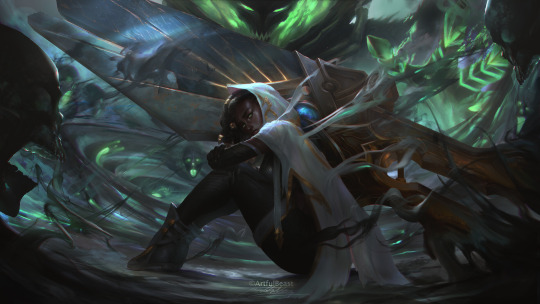
(Artwork by Paul Nong)
THE BUILD
LEVEL 1 - CLERIC 1
Senna started out as a Sentinel of the Light, which means that we’ll be starting off with Cleric. (Truth is that we’re mainly doing this for Saving Throws.) Clerics get proficiency in two skills from the Cleric list: choose Medicine for sure along with any of the other skills on the list: they’re all in character for Senna. (I personally opted for Insight.)
But unlike most subclasses Clerics get to choose their archetype at first level and Grave Domain Clerics fight for the dead and the living. Grave Domain Clerics are part of the Circle of Mortality: if you cast a healing spell on a target with 0 hitpoints they are automatically healed the maximum amount, and you get the Spare the Dying cantrip with an extended range of 30 feet. Spare those whose souls have already been lost, and keep those on the brink of death alive for the fight to come.
Your training as a Sentinel of the Light also lets you see what needs to be purified with Eyes of the Grave. You can use an action to detect any undead within 60 feet until the end of your next turn. You can’t sense them if they’re behind total cover or are protected from divination magic, and you know nothing about them other than the fact that they exist. You can use it a number of times equal to your Wisdom modifier and regain all expended uses when you finish a long rest.
But Clerics get Spellcasting and... woo boy there’s a lot to say here. Let’s take it from the top!
Mark of Finding Humans get Finder’s Magic, allowing them to cast Hunter’s Mark once per Long Rest.
Death Domain Clerics have the Bane and False Life spells always prepared.
You get 3 cantrips at level 1: Guidance lets you help Lucian with his dashes or his taxes, Light lets you provide a light in the darkness (duh), and Thaumaturgy lets you use the Curse of the Black Mist to do some spooky things. (Read the spell for the full list of effects.)
Finally you can prepare 4 spells at this level: Healing Word will let you quickly pop a heal at range with Piercing Darkness, Shield of Faith will let you shield your husband from a warden’s hook, Guiding Bolt will let you mark an enemy for your allies to assist with, and Protection from Evil and Good will protect any Purifiers while they try to save you.
Clerics get to prepare their spell list daily so be sure to swap your spells out for what you need: I’m just making suggestions.
IF USING CLASS FEATURE VARIANTS UA: Cause Fear is very in-flavor for Senna but is unfortunately restricted to the Class Feature Variants UA, so only take it if you’re allowed.
But remember that Clerics are prepared spellcasters, meaning that you can swap out your spells at the end of a Long Rest. I’m just picking the spells that are the most in-character for Senna but you’re more than welcome to choose something you think will be more practical.
Oh and as far as Senna’s Relic Cannon goes: at this level you can only use a Light Crossbow, but we’ll get the option to use something heavier soon enough.
LEVEL 2 - CLERIC 2
Level 2 Clerics can Channel Divinity for the light of Demacia aid them. All Clerics can Turn Undead to force undead to make a Wisdom save or run from the reconning. Grave Clerics can also mark a target with Path to the Grave, giving them a Last Embrace and vulnerability to the next shot fired at them. Light them up so Lucian can shoot them down! You can use your Channel Divinity once between short rests.
IF USING CLASS FEATURE VARIANTS UA: You can also use your Channel Divinity to Harness Divine Power, getting back a level 1 spell slot as a bonus action. It’s not much but it’s certainly something.
You can also prepare another spell like Detect Magic to know if anything is hidden in the mist, and if that spider really is a spider.
LEVEL 3 - RANGER 1
Hopping over to Ranger to learn how to shoot a Relic Cannon! Firstly you gain Martial weapon proficiency as a Ranger which will let you swap out the Light Crossbow for a Heavy Crossbow to replicate the Relic Cannon flavor. But more importantly you get another skill proficiency from the Ranger list and the Athletics skill will help make up for your low Strength score.
You also get a Favored Enemy: obviously you’ll be fighting Undead with your husband’s help. You have Advantage to track or remember information on your Favored Enemy. You also get another language and I’d recommend picking whatever’s useful.
You’re also a Natural Explorer in your favored terrain and I’d argue that the Shadow Isles are a Swamp of sorts. You get a bunch of advantages while traveling through your favored terrain which I recommend you read on your own time.
Of course mind you that these are just suggestions for these features: remember that Ranger is a class you have work with your DM in order to get maximum value out of them. Talk to them about what you’re going to fight and where you’ll be: Senna can shoot Galio just as well as Thresh.
IF USING CLASS FEATURES UA: Natural Explorer is replaced with Deft Explorer - I recommend the Canny feature for more help your husband out some more. Take the Perception skill and Expertise in either Medicine or Survival to keep fighting on the Shadow Isles.
Favored Enemy is also replaced with Favored Foe: you can cast Hunter’s Mark a number of times equal to your Wisdom modifier and don’t need to concentrate on the spell. These uses of Hunter’s Mark come back on a Long Rest just like your class feature Hunter’s Mark, so I’d suggest saving them for when you need to concentrate on something else but still dish out extra damage.
In addition 3rd level Humans with the Mark of Finding can cast Locate Object without using a spell slot once per long rest, so if you need to find a giant stone gun or a lantern you won’t have any trouble finding it.
LEVEL 4 - RANGER 2
Second level Rangers get a Fighting Style and while Archery may imply the use of a bow it works just as well for aiming a giant hunk of lightstone with a +2 chance to hit.
You also get access to Ranger spells at level 2: Zephyr Strike speeds you up for Absolution, letting you avoid Attacks of Opportunity when you move. In addition you can give yourself Advantage on an attack roll, ending the spell to increase your damage with 1d8 Force and giving you 30 feet of additional movement speed for the turn.
Hunter’s Mark meanwhile is likely a spell you’ve gotten used to since it’s part of your race: you can mark a target to a d6 extra damage to them and have Advantage to track them. You can move the mark to someone else within 90 feet of you if the original target dies.
LEVEL 5 - RANGER 3
At level 3 you get to choose your Ranger Conclave and Gloom Stalker is perfect for those that spend their life running from the mist. You get Umbral Sight which increases your Darkvision by 30 feet and helps you hide in the mist, making you invisible to any creature with Darkvision if you’re standing in darkness. You also get Dread Ambusher: you have a bonus to your initiative equal to your Wisdom modifier and during the first turn of combat your walking speed increases by 10 feet. In addition you can attack twice on your first turn, and your second attack will do an extra d8 of damage. Just a reminder that technically you can’t attack twice with your Heavy Crossbow, but if you have a nice DM or an Artificer willing to lend you a Repeating Crossbow it is fine. Alternatively you can just use a Longbow and reflavor it as a Relic Cannon.
You also get Primeval Awareness, letting you use a spell slot to detect if there are any aberrations, celestials, dragons, elementals, fey, fiends, or undead within 1 mile of you. Or alternatively you can use Primal Awareness to get access to some innate spells. I suggest looking at the Class Feature Variants UA for a list of the spells you can cast with Primal Awareness.
You also get access to the Disguise Self spell for free along with one new spell of your choice: take Ensnaring Strike to lock your enemies down with Last Embrace. “One last breath...”
LEVEL 6 - RANGER 4
4th level Rangers get an Ability Score Improvement and seeing as our Dexterity score is uneven grab the Resilient Feat for Dexterity for proficiency in DEX saving throws and an increase to your DEX modifier.
WHY NOT ANOTHER FEAT? - The only other Feat that increases Dexterity which would be useful for us is Athlete, which isn’t too important for a ranged build.

(Artwork found on lol.gamepedia)
LEVEL 7 - RANGER 5
5th level Rangers get an Extra Attack. Note that if you’re still using the Heavy Crossbow you can only attack once per round, which does mean that you can’t use Dread Ambusher or your second attack with RAW. What I’m saying is even though a Heavy Crossbow makes more sense in-character it would probably be better for the build if you used a Longbow instead.
You also get access to second level Ranger spells at 5th level. Gloom Stalkers know the spell Rope Trick innately so you can climb back into the lantern for safety... I don’t think the lantern is safe. Take Spike Growth for some more misty spikes to slow down your foes.
LEVEL 8 - RANGER 6
6th level Rangers get another Favored Enemy and Favored Terrain from Natural Explorer. Again feel free to metagame with your DM and ask them what to pick, or alternatively take the Tireless feature from the Deft Explorer Class Feature Variant so you can keep running even if you’re hit by Exhaust... both the summoner spell and the D&D debuff!
LEVEL 9 - RANGER 7
7th level Gloomstalkers get Iron Mind, giving them proficiency in Wisdom saves... but if you didn’t notice we already have proficiency in Wisdom saves, and since our other two options are either Charisma (which we have) or Intelligence go for proficiency in Intelligence saves instead. Isn’t it great when everything works out?
You can also learn another Ranger spell and Healing Spirit lets you summon a friendly Mistwraith to heal your allies. Whenever a creature moves through the spirit’s space they heal a d6 of health, and you can move the spirit up to 30 feet on your turn as a bonus action.
LEVEL 10 - RANGER 8
8th level Rangers get another Ability Score Improvement: increase your Dexterity again for better accuracy and more damage with your Relic Cannon. You also get Land’s Stride which lets you ignore the plants of the Shadow Isles and gives you advantage to get past magical plants that are trying to stop you.
LEVEL 11 - CLERIC 3
Now that we can fight with the darkness it’s time to fight with the light. 3rd level Clerics get access to second level spells like Blindness/Deafness to hide your allies in the mist... against one enemy. Still useful to get the jump on them.
You also innately know the Gentle Repose spell as well as Ray of Enfeeblement. Keep Lucian away from Thresh by Exhausting him if he comes close!
LEVEL 12 - CLERIC 4
4th level Clerics get another Ability Score Improvement: cap your Dexterity for maximum accuracy and saving throws with your Relic Cannon.
You also get another spell and another cantrip: Word of Radiance lets you shout “DEMACIA!” to force enemies close to you to make a Constitution saving throw or take Radiant damage. Hold Person (once again) lets you send out a Last Embrace to hold your foes down for your allies to take care of them.
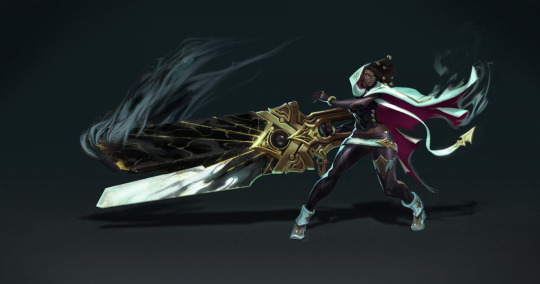
(Artwork by Riot Games)
LEVEL 13 - CLERIC 5
5th level Clerics can Destroy Undead with their Turn Undead feature if the undead is of CR 1/2 or lower.
You also get access to 3rd level spells: Bestow Curse lets you bestow the Curse of the Black Mist on an enemy granting a bunch of effects which you can read on the spell list. In addition Grave Clerics always have the Revivify and Vampiric Touch spells prepared, so you can repay your husband for saving you before screeching at those who’d take him from you.
LEVEL 14 - CLERIC 6
6th level Clerics get another use of their Channel Divinity for more undead destruction and more marks for your allies. Additionally Grave Clerics get Sentinel at Death’s Door, allowing them to negate a critical hit on an ally. Fire off Dawning Shadow to shield Lucian. “For the light.” “And all lost in darkness.”
You also get another spell and Mass Healing Word lets you hit a multi-person Piercing Darkness.
LEVEL 15 - CLERIC 7
7th level Grave Clerics get access to 4th level spells. As a Grave Cleric you know the Blight and Death Ward spells innately, letting your enemies wither away in the mist and your allies survive even the toughest blow.
For your spell of choice choose Banishment to send the shadows back from once they came.
LEVEL 16 - CLERIC 8
8th level classes get another Ability Score Improvement: increase your Wisdom to get into the fight faster and improve your spellcasting.
8th level Grave Clerics get Potent Spellcasting but if you haven’t noticed we’re going for a weapon-based build so ask your DM to instead use the Blessed Strikes feature from the Class Feature Variants UA to do an extra d8 of Radiant damage with one of your attacks. The Piercing Darkness is mixed with the light, after all.
You can also prepare another spell and Stone Shape lets you form some relicstone into a massive cannon to fight off the darkness... or to make a passage through a wall. Guardian of Faith will let the light of Demacia protect you from any ghouls trying to grab you.
In addition your Destroy Undead feature now destroys undead of CR 1.
LEVEL 17 - CLERIC 9
9th level Clerics get access to 5th level spells. As a Grave Cleric you always have the Antilife Shell and Raise Dead spells always prepared: don’t worry though this is the good kind of Raise Dead where the person is just alive, not a mindless zombie.
For your spell of choice prepare the light of Dawn to strike down your foes.
LEVEL 18 - CLERIC 10
10th level Clerics get Divine Intervention. You can call the gods of Demacia to help you in a time of need. When you do the DM rolls on a percentile die and if the percentage is equal to or lower than your level (so right now 10, or a 1/10 chance) the gods will hear you and help you. You can only call for help once per long rest and if the gods do help you the feature is put on cool-down for 7 days. Never underestimate the power of a light in the darkness: they have long cool-downs for a reason.
You can also prepare another spell and Holy Weapon lets you channel the light into your Relic Cannon, making your weapon attacks do an extra 2d8 of Radiant Damage, and gives you a radiant burst to blind nearby enemies and do 4d8 damage to them.
You additionally get another cantrip and once again I’m largely stumped on what to take, so grab Toll the Dead so the creatures of the mist know their time is up.
LEVEL 19 - CLERIC 11
11th level Clerics can Destroy Undead of CR 2, and can prepare a 6th level spell like Heal.
LEVEL 20 - CLERIC 12
Our final level is the 12th level of Cleric for another Ability Score Improvement: if you want better spells go for more Wisdom but if you want to shoot your gun better I’d suggest finally taking the Sharpshooter Feat. This will let you ignore half cover and three-quarters cover and also shoot from your maximum range without disadvantage. But most importantly you can take a bit of a harder shot to instead receive +10 to your damage roll! “Handled.”
For your final (two) spells of choice Word of Recall lets you quickly recall to your Nexus along with your friends, and True Seeing will let you see if anything is trying to hide from purification or redemption. But again I need to mention that Clerics are prepared spellcasters, so prepare the spells that are useful in the moment.
FINAL BUILD
PROS
Out of the lantern... - You are remarkably resistant with above-average health and proficiency with every type of saving throw except for Strength and Constitution, not to mention all the spells you have to buff yourself and your allies.
Hell came with me - You have immense damage output and utility in a fight. +10 to initiative with 3 attacks on turn 1 plus an extra d8 of damage. You also have a huge array of spells and spell slots going up to 8th level, with spells like Hunter’s Mark, Bestow Curse, and Holy Weapon all buffing your Relic Cannon.
I can handle this gun - You have a good deal of utility to provide to yourself and your party. Again I mention your Cleric spells but you also have a large array of proficiencies to be useful out-of-combat as well.
CONS
If you've got a problem with me, make it two - Like I mentioned in the pros section your two big Achilles' heels are Strength and Constitution saves. The low CON modifier in particular is a big issue since it means that you will be dropping Concentration spells frequently.
It’s the dream that makes us giants - Speaking about concentration: the spell list I recommended has a lot of them. You have an ungodly amount of Concentration spells at first level alone and it only gets crazier at higher levels.
Running with a gun in your hand - Senna operates best at range but unfortunately she has very few options to actually make distance for herself. That problem extends into this build as you rely almost entirely on being in the backline away from any Mist Wraiths that might want you.
But you’ve dealt with those problems all your life and they’re not going to stop you when you’re ready for a reckoning. I’m actually rather impressed with this build as it performs well across all levels of play. Fight along-side your husband as well as your team: heal the party, shoot the baddies, and be the light in the darkness. Just try to avoid being banished into a lantern for 6 years: Lucian needs you as much as you need him. "Lucian has a way of breaking down my walls."
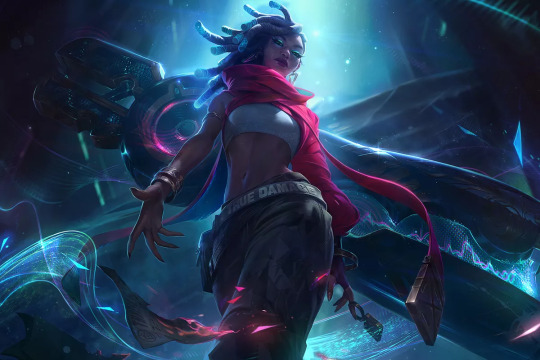
(Artwork by Riot Games)
13 notes
·
View notes